Rifts World Book 19: Australia by Alien Rope Burn
"Enter Ben Lucas, a very affable and energetic lad with a good feel for Rifts® and a keen sense of Australia."
Original SA postRifts World Book 19: Australia posted:
Warning!
Welcome to 1999!
Rifts World Book 19: Australia posted:
Violence and the Supernatural
That means we're finally covering books that are less than two decades old at the time of this writing.
Rifts World Book 19: Australia posted:
The fictional World of Rifts® is violent, deadly and filled with supernatural monsters. Other dimensional beings often referred to as "demons," torment, stalk and prey on humans. Other alien life forms, monsters, gods and demigods, as well as magic, insanity, and war are all elements in this book.
And nine years worth of Rifts books have been covered overall.
Rifts World Book 19: Australia posted:
Some parents may find the violence, magic and supernatural elements of the game inappropriate for young readers/players. We suggest parental discretion.
Wait. What I have been doing?
Rifts World Book 19: Australia posted:
Please note that none of us at Palladium Books® condone or encourage the occult, the practice of magic, the use of drugs, or violence
Somebody stop me before I review again-
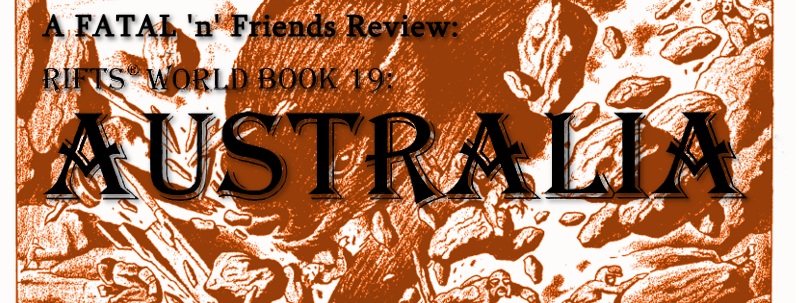
Rifts World Book 19: Australia, Part 1 - "Enter Ben Lucas, a very affable and energetic lad with a good feel for Rifts® and a keen sense of Australia."
So, we get a bit of a break from Siembieda this time around. But don't worry, Siembieda fans. He's here with some edits and additions to ensure this is as riftsian as it needs to be. This book was done by Ben Lucas. But the notion is familiar.
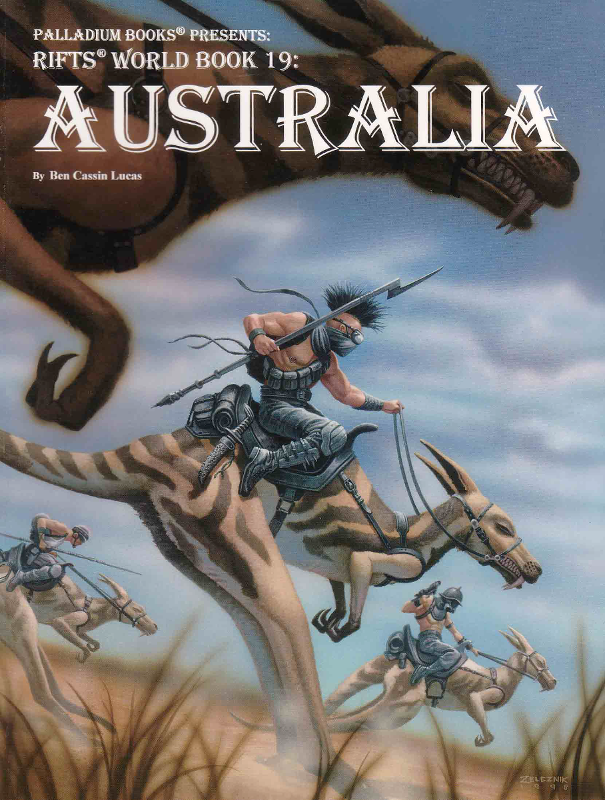
Rifts World Book 19: Australia posted:
Magic touched the land, and the native tribes were given their calling to retake their country. And now they flourish. In the aftermath of the Great Cataclysm, the white community was left without support — no cities, no technology.
Because, of course, every other group of people was just waiting for the apocalypse to dial things back several centuries and show off their ancient wisdom. I swear if these books weren't written by Americans, then America would be populated by puritans, witches, and Ben Franklins living in log cabins and using masonic magic.
But this, apparently, only the start of a Rifts Australia series of books!
Rifts World Book 19: Australia posted:
Enter Ben Lucas, a very affable and energetic lad with a good feel for Rifts® and a keen sense of Australia. Now, those of you in the know, might say, "well of course he has a good feel for Australia, for Pete's sake, Ben is Australian," but Palladium had gotten more than a few manuscripts over the years from other Australians that we found wanting for one reason or another, and were rejected. All of us at Palladium thought Ben did a nice job through and through. Best of all, this should be just the first of several Rifts Australia books — hey, it's a big island continent and there are lots of cool stuff to write about.
Specifically, there was supposed to be Rifts Australia 2 (*deep breath*), covering the indigenous peoples of Australia and their magic, and a Rifts Australia 3, covering the Dreamtime as its own dimension. For whatever reason, we're nearly two decades on and neither has emerged. Given how Africa and Spirit West came out, that's probably a blessing. However, even as recently as Rifts World Book 18: Mystic Russia, there was an advert promising "Dream Time magic and Song Lines" in this book. Song Lines is just the local term for ley lines, so I guess they're technically in, but "Dream Time magic"? No, it never shows up.
Glossary of Australian Slang, Terms & Language
It wouldn't be an Australian book without Australian words to remind us that we're in Australia, y'see. It makes wonder if any British or Australia RPG books about America explain some American words, like moxie or wiseguy.

I'll skip all the classically Australia lingo (or, at least, classic to any Australia-themed RPG book I've opened, I don't know how much Australians actually use the lingo we love to reproduce) and instead focus on the new terms; I'm not going to go over billabongs and tuckerbags.
Administration refers to the government of the closed cities of Perth and Melbourne (much more on that later) and their agents - so soldiers venturing out are "Administration" too. Those cities are also known as "tech-cities". People from those places are called city-goers.
Outbackers refers to the majority of non-indigenous Australians living outside those cities - pretty much any place outside of the cities is the Outback, not just the wilderness. If you're an outbacker and you ride around on a vehicle making life tough for others, you're probably a roadganger. Outland is the inland desert, and outlanders are the nomads who live there.
Ley lines are now songlines. Aboriginal is very unfortunately used as a noun and not an adjective, but we're told "Tribals" is the respectful term. Pretty sure not, but I'm hardly Australian. As best as I understand it, "Aboriginal" as an adjective is fine, but as a noun it's... dated, let's say. In any case, not all Aboriginal communities would use the term "tribe" anyway.
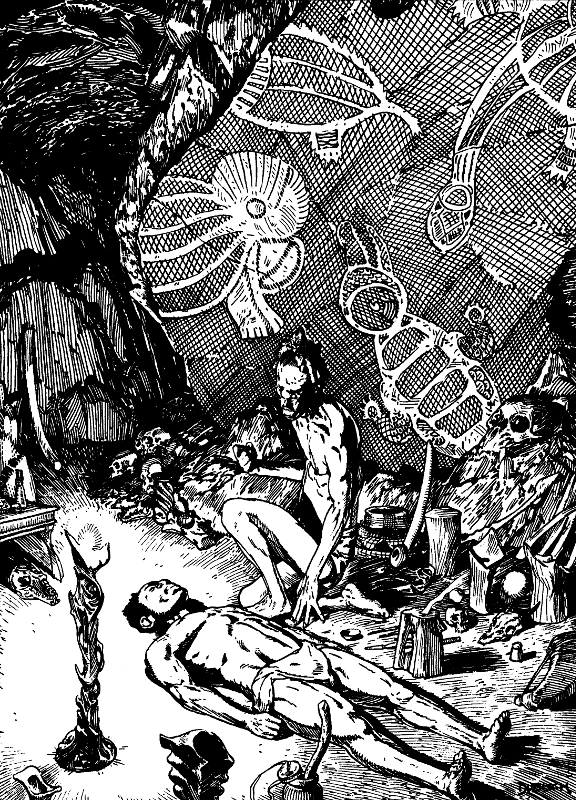
"It is a ritual of hope, so that we might be detailed in later books."
Let's aside about that. Like Spirit West or Mystic Russia, that sort of rough term will come up a lot. Such terms will be popping up in direct quotes or possibly even chapter headers. You won't hear them in my direct text - Aboriginal peoples or Aboriginal Australians will probably be my go-to term, or indigenous peoples. Ideally, I would refer to them by their actual nation, clan, alliance, language group, etc. names - but the book practically never refers any specific such thing for me to reliably use, instead treating them as an indistinguishable melange.
Similarly, it refers to all Aboriginal sorcerers or shamans as "Mabarn", even though that's a somewhat incorrect term as I understand it. Mabarn is a magic or medicine used by the maparnjarra, a shamanic tradition specific to the Ngaanyatjarra people. I can understand trying to simplify things for an RPG, but if you do that, it'd probably be better to use a more generic term.
Rifts Australia, an Overview
Differences of Opinion
Three outlooks at Australia after the Coming of the Rifts®
We get three different narrative chunks here. The first is "A Walkabout by Ernie Longpath, Native Tracker".
Rifts World Book 19: Australia posted:
The Apocalypse stripped 'em of that, gave us back our magic. Brought magic to the world like it was for our ancient ancestors. The way we knew it would be again one day. We took our land back when the spirit returned to it, and the white fella was left flounderin' like a fish on a hot rock — good as dead but goin' mad tryin' to live.
Yes, the apocalypse came and Aboriginal Australians were like "subsistence hunting and gathering is here again, fuck and yes" and instantly adapted to culturally distinctive wizarding and making wild animals dead. "Whitefellas" had it tougher because they're crazy and fight each other all the time! Aren't they so crazy?
The next is from Outback Reconnaissance Report 317 by Lt. Cass Crowe, Aerojock for Melbourne's 21st Helicopter Deployment, a pilot from Melbourne. He was supposed to napalm a group of raiders, but they were surprised when the local Outbackers revealed missile batteries and shot him down and some of his fellows down. He wakes up in Outbacker territory, having his wounds cared for, and they let him live - provided he tells Melbourne Administration that they're planning to resist the city's influence, and one day tear it all down, fuckers. He considers them a bunch of barbarian "animals", but admires their rebellious passion. He worries that the Administration is too apathetic, and that they need to find a way to interact with the outside world before it swallows them up.
Lastly, there's "A conversation with Gordan Sterling", an Outbacker and Explorer of the Northern Coasts. He's studied history and he talks about the land being "sacred" but then the British Empire came along and made it "boring". (No, really.) And now things are better because people have to re-explore everything, and as an explorer, he really digs that. He's worried about crazy raiders, though. He casts shade on Perth and Melbourne, saying they only survived because they weren't worth nuking. Also the "Tribesmen" are awesome and magical and he's cool with their awesome magicalness, good for them! He doesn't trust white wizards, though, they're crazy.
Rifts World Book 19: Australia posted:
I love exploring this land of ours, and I'll never be bored here or sad that the old days of Civilization are gone. Not really sad, anyway, I'm a simple man, and don't know no better.
Next: Australia gets wet.
"According to legend, he is the one who will destroy the world by drinking all the water."
Original SA post
Rifts World Book 19: Australia, Part 2 - "According to legend, he is the one who will destroy the world by drinking all the water."
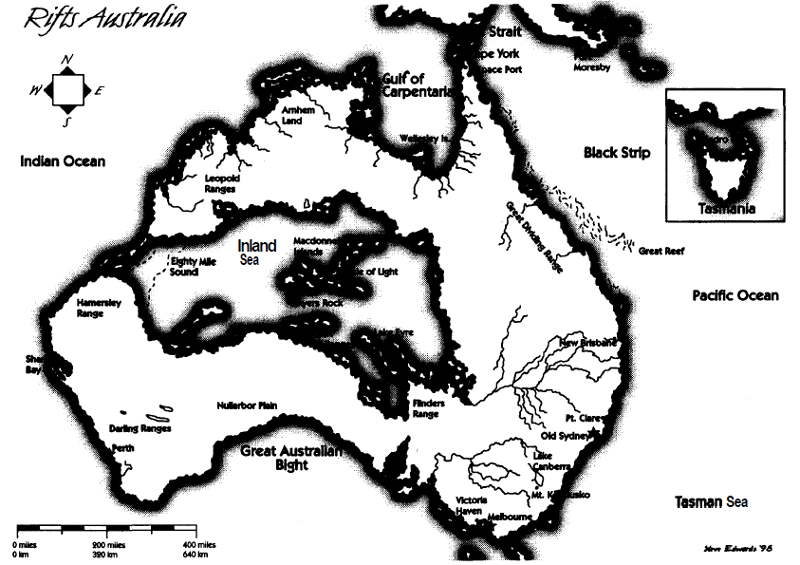
"We'll live inland, where sharks can never reach- OHGOD-"
Geography
So, we start off with a map and some statistics. Most of the population is evenly divided between Aboriginal people (one-third), city-based humans (one-fourth), and Outback humans (one-fourth), with a minority of mutants and D-Bees. We get the clarification when they say "white" they also mean other immigrants like Asians and mainland Europeans, and that the main divisions are between the cities and Outbackers, or Outbackers and indigenous Australians.
The big change that you'll see from the map is the fact the sea broke through on the west side of the continent and created the Inland Sea. Apparently increased salt levels have caused the deserts to grow, pushing vegetation towards the outer edges of the continent. A lot of rivers have changed course, been created, dried up, etc. Most of the old cities were destroyed or reduced to ruins.
Outbackers mostly survive in small communities, though shantytowns exist outside of the two major cities - like the 'Burbs of the Coalition. While generally less advanced, they're also less crime-ridden. Some Outbackers dream of entering the cities, but most have accepted their fate in the wilderness. To the North and in the desert, things get more vicious and wild. Meanwhile, Aboriginal people have inherited the land largely because they were away from most civilized centers where the destruction was worst. I mean. Aside from the whole area that became a new sea. But nevermind that! Anyway, we'll get more in the Dreamtime sourcebook on that. Which has never come out. I suppose it was only a... dream.
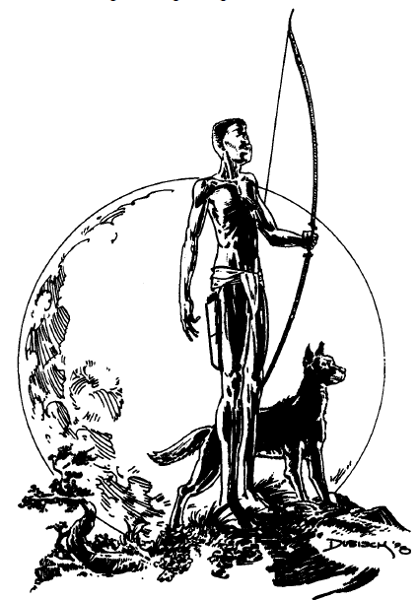
"We hunt onward, for the book we might appear in."
We get a lot of facts about Australian heat and soil and other such things, but the more unique thing is that apparently it's a "very magical land" like England is. This hasn't gone unnoticed, and a number of alien intelligences and gods are trying to set up shop - as well as some Millennium Trees (as in Rifts World Book 3: England. It's also implied the Great Reef is some kind of "Millennium Being" several times in the book but never really detailed. A unique aspect to the magic here is "The Dreaming" where apparently Australia is a literal magical place that prefers indigenous people and nature because... it does, but "most white people" can't see it. Demonic predators have also been attracted here, and we'll see more on them later, but apparently the Aboriginal peoples are most often the ones holding the line against them.
Man, this was supposed to be a geography section? Well now we're going on about gods like The Bunyil and the Rainbow Serpent returning to the land to help out indigenous people. However, a massive frog-demon named Tiklik has arrived and sleeps under the Inland Sea. It's said he'll drink up all the water in the world, but more likely he'll just rampage and need to be anti-rampaged.
In any case, there a fair deal more on the local flora and fauna, but most of that can be wikipedia'd. However, there's new but mundane flora introduced by the rifts.
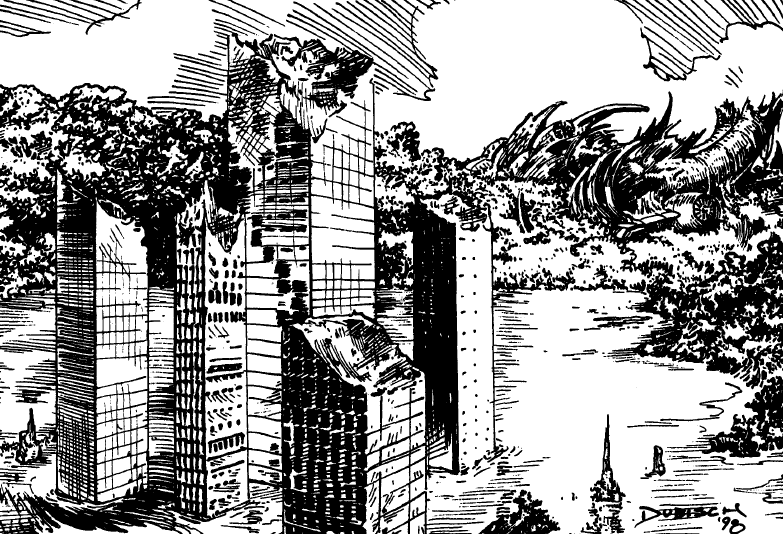
Cardhalla.
Landmarks
Places of note in Rifts Australia
The Old State Borders
While the old states no longer exist, we still divide things up by them because convenience.
- Northland: Mainly dominated by the Mokoloi (crocodile guys) who live in the swamps. While Arnham land and Bana-land contain beautiful natural sites, it's troubled by a radioactive zone and demon invaders. Off the south coast of the Inland Sea is where Tikilik sleeps, atop the now-submerged ruins of Alice Springs.
- Western Australia: Mostly desert and scrubland, this is mainly notable for the walled city of Perth, indigenous tribes, and some minor faerie and elf incursions. Shark Bay is a home to a secret base of Horune pirates (from Rifts World Book Seven: Underseas).
- Queensland: The Great Reef is said to be a paradise, but a gauntlet of bandit gangs and monsters makes getting across Queensland difficult. It's said even the Aboriginal peoples try and lay low and avoid the rougher inhabitants. Wellesley Island is home to a vampire intelligence (as in Rifts World Book One: Vampire Kingdoms). The ruins of the Cape York Spaceport have become a safe haven known as York Station. While not strictly secret or closed, they try and maintain a low profile. (This book was written in the late '90s and presumes the Cape York Spaceport would eventually be built - it never actually was.)
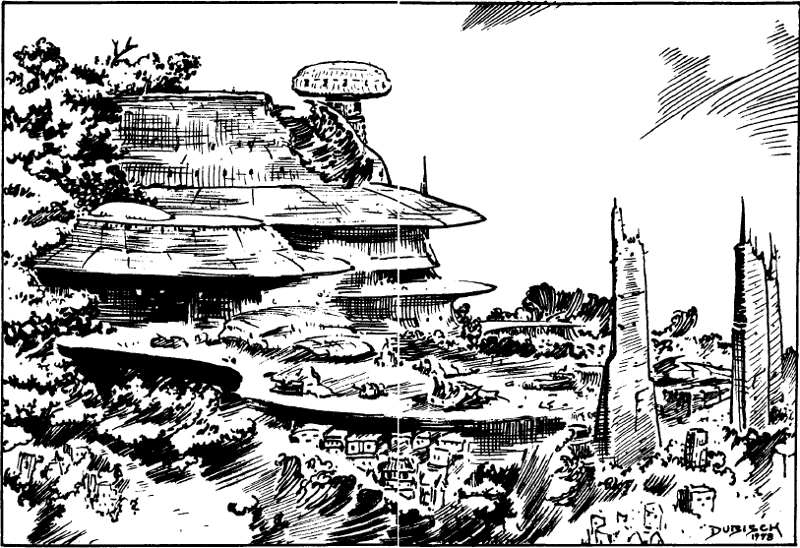
It never was, but now is?
- New South Wales: Mostly just river communities of Outbackers, roadgangers on suriving roads, and indigenous people outside of the mountains. Canberra was entirely flooded, and Lake Canberra could be a treasure trove of technology and history- but it's apparently flowing with magical energy, making it extremely dangerous. Melbourne has set exploration teams that never returned, and we get a lot of handwringing that emphasizes the ruins may have been plundered already (or "will take months if not years" to unearth) for GMs worried about letting PCs have cool stuff for hard work. I guess the real treasure was all the monsters and hazards that tried to murder us along the way! Sydney has become "Ol' Sydney Town" atop the ruins, a lawless den of crims, "sub-demons", and Outbackers. The Sydney Opera House was submerged, but has become a ley line nexus that barfs out monsters on a regular basis.
- Victoria: This has the most surviving people, mostly on account of Melbourne surviving and large Outbacker communities. However, it also makes it a sweet spot that attracts supernatural menaces that seek to break them. Though there are ruins, most of them have already been stripped - though there are always new discoveries. Melbourne is trying to set up a "Eastern Humanity Republic of Australia", or EHRA, and has imperialist dreams, but pushback from Outbackers, raiders, Aboriginal peoples, etc. keeps them from trying to make their own little psuedo-Coalition State so far.
- Tasmania: Though the island was wiped clean of humanity, Melbourne has been using Sabro Island as a dumping ground for exiles and undesirables. Rumors of cannibalism may or may not be exaggerated. Tasmania has had some new if few immigrants in the form of Outbackers and local indigenous people, and Hobart may still hold pre-rifts treasures.
- South Australia: While much of the state was flooded, and though there are some industrial communities, they seem to be on the decline due to a largely barren landscape and high supernatural activity. The deserts have cannibal roadgangers as well. Because of this, Perth and Melbourne are likely to trade by sea rather than bother establishing any overland routes through this region.
- The Island Sea: Generally speaking, there isn't much travel or habitation here due to sea creatures and the presence of the Tikilik demon. If external factions like the Horune or Naut'yll have visited, they haven't stayed.
- Islands of Light: A set of islands born out of the MacDonnell ranges in the Inland Sea, and it's said monsters and otherdimensional beings inhabit them, as well as the "Visisari aliens". We're told they'll be detailed in the race section! They are not. They will never be mentioned again in these pages.
- Ayers Rock: Now located at the bottom of the Inland Sea, it's a powerful nexus point that creates a "dead zone" (that is, most things coming through the rift there drown, creating a zone of corpses and ghosts). However, there's a "ghost rock" atop the surface of the water that can be seen from nearby islands, and some Aboriginal mystics claim they can climb it through spirit travel and "soak up the pure spirituality of the land". What does that mean? I got nothin'.
- Mount Olga: As an "important Aboriginal site" and ley line nexus, it's protected by local indigenous peoples despite the risks. There are also apparently a fair number of Shadow People here. They'll be detailed later.
- Lake Eyre: One of the first places to be submerged, the site of the lake has become a large dimensional portal that can be seen from the surface when it activates, but it's too deep to easily access. We're told it can lead to Wormwood (of Rifts Dimension Book One), Phase World (of Rifts Dimension Book Two and Three), the Astral Plane (some Nightbane book, I guess?), Chaos Earth (the book for that will not be released for four years and will turn out to be Rifts' past), and the Dreamstream™ (of Nightbane). It can also lead to the past or the future, despite Dimension Book 4: Skraypers implying rifts didn't time travel. Well, it's a very special nonlake.
- Three Sisters: Three rocky towers, that used to be a popular point for Outbackers to climb, "The Aborginals always knew better." The nexus point they represent has been growing in power until it's no longer safe to ascend, and trying to climb too high will get you dumped in another dimension or probably get you attacked by an extradimensional critter.
- Arnhem Land: A lot of this has become mangroves, forests, and swamps controlled by the hostile Mokoloi. The southern area has become dominated by magic and alien radiation, forming-
- The Radiation of Bana-Land" Also known as The Dead Zone. The magic here is plentiful, but doing so will cause physical burns because the flow is so intense (10 PPE = 1 point of damage or 100 PPE = 1 mega-point of damage) and suffer penalties to anything that isn't wizarding. Psychics just suffer terrible penalties in general unless they put a mind-block up, and normal people become stressed to a breaking point if they stay too long (days or weeks, mind). In addition, supernatural creatures and mystics can sense when the energy of the land is drawn upon, meaning doing so can often draw supernatural menaces to prey on spellcasters. There's a dramatic formation of rock ridges at the southeastern end called the "Hidden City" (no real-life parallel I could find), and it's home to a community of Shadow People.
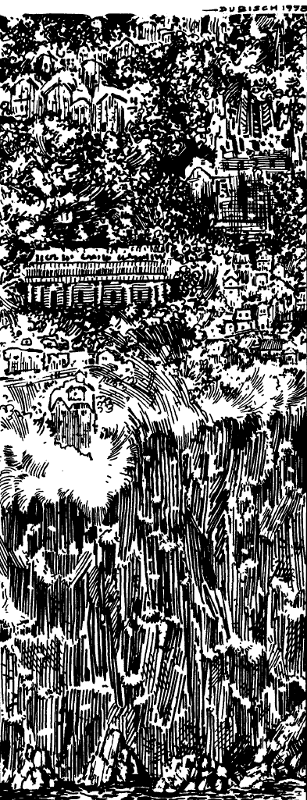
Landscapes may not be Dubisch's strong suit, sadly.
Next: If everything is the Outback, then nothing is!
"If a man cannot be trusted, he is as dangerous as the crocodile, and like the snaggle toothed croc, is to be feared and shunned by men."
Original SA post
Rifts World Book 19: Australia, Part 3 - "If a man cannot be trusted, he is as dangerous as the crocodile, and like the snaggle toothed croc, is to be feared and shunned by men."
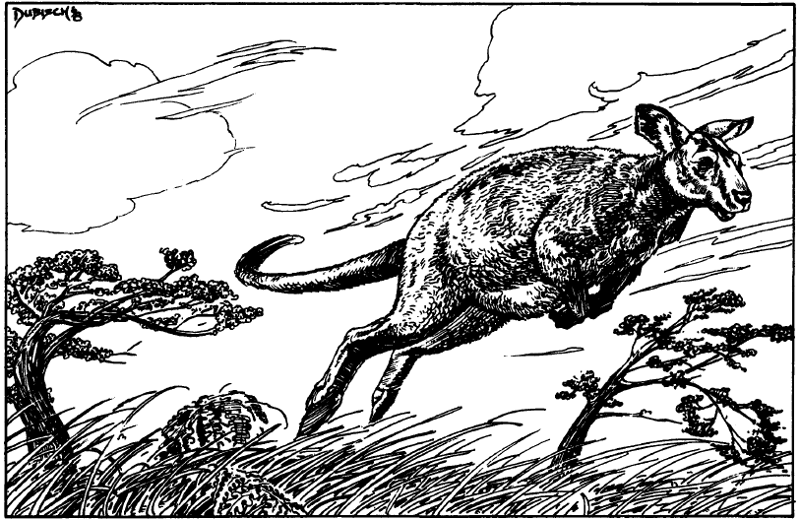
"Not extinct! Not it!"
The Outback & The People
So, we get a lot of vagueness thrown at the wall to show how different Outback communities can be.
Rifts World Book 19: Australia posted:
Good, bad or indifferent, social or anti-social, sedentary or nomadic, some groups and communities are wild and lawless, others quiet and orderly, some brutal and extreme, others cooperative and reasonable, and everything in between.
Anyway, their myriad differences often lead to conflict, and even though there's still a vague "Australian" national identity, it's interpreted in so many ways to be of dubious value. Most law enforcement follows a frontier town with a Sheriff, deputies, and a citizen militia, but some model themselves after militaries. Family and clans are the closest thing there is to a universal reality, and larger communities often see social status defined by one's last name.
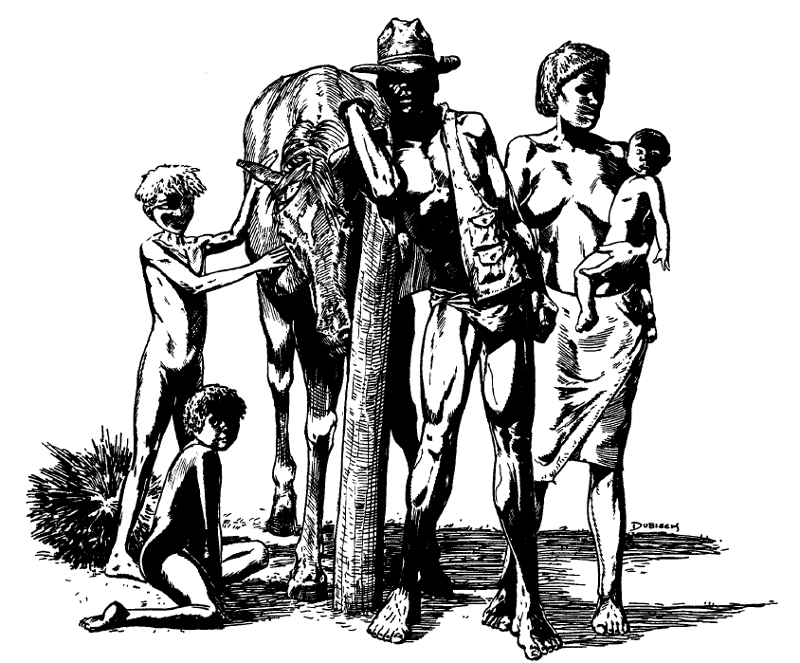
"Be patient, my children. We'll be in a book soon enough."
We're told that work dominates most peoples' lives, as the authors seem to be relying on the assumption that pre-industrial societies were backbreaking lives of total peasant drudge, which isn't entirely true. Still, freeloaders and those not carrying their weight without some actual excuse (physical disability, age, illness, etc.) are usually booted from the community. Most communities are fairly isolated, and finding certain resources can often be a make-or-break issue for many communities. Technology has largely regressed outside of the two big "tech-cities". Combustion engines are the most common source of power, computers are generally simple, and magic is usually used for communication when available. Often technology is jury-rigged or scavenged in the usual Rifts humble jumble sort of way. In general, technology tends to be lower than seen in many other parts of the Rifts setting (like North America).
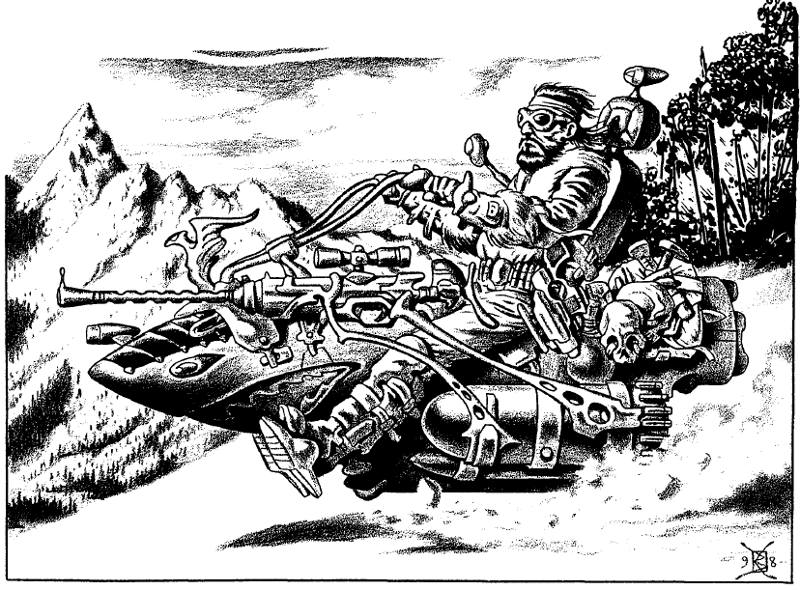
"I don't know what I'm riding and I don't much care."
The Code of the Outback
It's not really a code, even though we just called it a code! They just like writing codes at Palladium. But these are values generally felt by many Outbackers.
- Conservation of Resources: Don't waste shit.
- Preserve the Land: Don't fuck shit up.
- Respect the Land: Don't fuck with nature.
- Exercise Caution: Don't be a fuckwit.
- Fire is Dangerous: Don't fucking burn everything down.
- Rely on your Mate: Don't you dare fuck me.
- Fear: Don't you fucking freak on me.
- Life: Don't be a fuckup.
This section uses the organizational rules first introduced in Ninjas & Superspies, which made some sense because they defined what your ninja or superspy could ask for. If your superspy needed a stealth toboggan for a Netherlands adventure, you just look up the vehicle entry and see what they have available. It wasn't much of a system beyond just codifying entries, but it had a purpose. You pay points from a pool to get access to a resource. Mind, there are no rules for growing an organization or changing them, nor any fixed amount of points you get, so the whole thing is at the whim of the GM.
Then, the same system was used for circuses for some reason in Rifts World Book 1: Vampire Kingdoms where it made less sense, unless the PCs are all working for a circus. I mean, it certainly defined how many trucks a circus had or how many jugglers they could access, but that wasn't essential information. Rifts Mercenaries used it for mercenary organizations, which seems more like something you'd see PCs working for. And Rifts World Book 19: Australia users it for Outback communities. This makes some sense, presuming you want a group entirely based around a single community. On the other hand, it's painfully dry.
Rifts World Book 19: Australia posted:
K. Trade
This represents the willingness and ability to trade with other settlements and perhaps even the cities of Perth and Melbourne. This will raise the wealth, resources and diversity of equipment the community has available to it, some of which may be quite exclusive.
1. None. Although the occasional item, service or bit of in formation may be sold or traded to a passing traveler or neighbor, there is no type of formal or organized trade operation. This community can either barely support themselves, or are self-sufficient isolationists who want nothing to do with outsiders. Cost: None.
2. Internal. Trade of goods and services goes on only within the community. Money and trade goods actually have meaning to the people within the settlement, but they seldom trade with the outside world. This community is usually self-sufficient, but afraid of the outside world and keeps contact to a minimum, has little of value that outsiders might want, or is geographically isolated in a remote or inhospitable (or inaccessible) place. On the other hand, the people may be isolationists who want nothing to do with outsiders. Cost: 2 points.
3. Limited. The community does have one or more trade goods or services they are willing to trade with others, especially nearby settlements, but nothing of great significance or tremendous value. Just enough basic things to keep avenues to resources they don't have themselves and communication open to the outside world. Cost: 10 points.
4. Established Trade. This settlement encourages trade and has well established trade operations and/or trade routes. They trade with other settlements and travelers alike, and may send agents, buyers and sellers hundreds of miles away to find needed and desired items. At least 33% of their revenues and resources come from trading. Cost: 15 points.
...
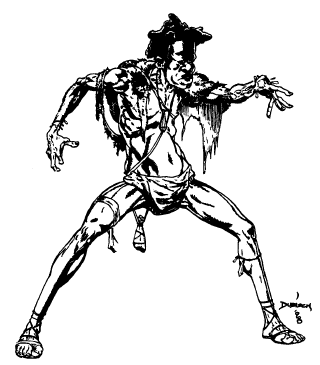
"And now, see the doom that awaits!- wait, I'm not in this book? Really?"
And that's just half of one of the lists. First you start off with "Orientation & Disposition" which is basically how your community reacts to outsiders and treats each other. Then we have "General Type & size of the Community" which determines how many points you get, from "Small Shanty Town" or "Family Commune" at the low end and "Major Town" or "Advanced Civilization" at the high end.Sometimes the amount is even randomized, like with "Militaristic Encampment", but the gamemaster is encouraged to just add or subtract points as they like.
Then you get to actually spending points, including:
- A. Weapons & Armor: What small arms and armor locals and defenders have access to. If you don't pony up for this category, it's either the PCs or nothing for defense.
- B. Medicine: As we're reminded, surviving critical injuries is based almost entirely on the medical facilities available. (And not how good your doctor is, which goes unmentioned.) So this could be important were in not for the fact that mega-damage will usually kill you outright.
- C. Water: If you don't spend for this, forget about baths, stinky.
- D. Agriculture and Natural Resources: Farms y/n?
- E. Real Estate & Location: Basically how safe or secure your settlement is, whether it's in a hazard zone or near m-m-monsters.
- F. Vehicles & Fuel: Finally, you get to use the vehicle extension of a book extensively!... there aren't many vehicles in this book, though, and it's hard to find vehicles from any other place in Australia. Post-apocalypse shipping is rough.
- G. Administration & Social Structure: "6. Utopian. Very rare. Historically, Utopian societies have never worked on a large scale, but can have limited success on a small scale (under 10,000 people; smaller is better), especially when a community is reasonably prosperous, and has a strong sense of identity, equality and camaraderie."
- H. Alignment: You have to pay more to be good. You have to pay to not have a community of sociopaths.
- I. Magic: How many wizards you got.
- J. Racial Tolerance: You have to pay for your community's racial tolerance. You have to pay points for racial tolerance. I think we just hit peak Palladium for this book.
- K. Trade: See above
- L. Threats: Wasn't being safe this covered under Real Estate & Location? Well, apparently not. Pay for it again, suckers!
- M. Skill Levels & Professionalism: Pay for local experts on a a la carte basis. Then pay again for the overall skill of your average community member. You can't get one without the other.
- N. Shelters: Roofs y/n? Or is that rooves? Rooves.
- O. Security & Fighting Force: Cops? Military? Well-
... y'know, I just realized I never actually finished this section but I think we can leave it there. I wonder if a group has ever confronted the essential dilemma: "You know, we could save some points if we can just put up with a bunch of racist psychopaths."
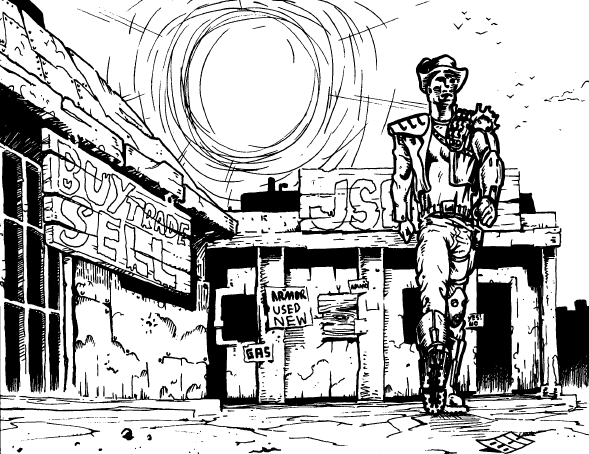
"Finally, got some nice random metal flair, I was feeling naked."
Some Notable Outback Communities
This is a short list of sample communities in the Outback, statted out with the above system.
- Sterling: This is literally just a generic sample community designed as a generic small town suitable for PCs to be associated with. Not much to say.
- Trade Town: Located on the western mountains of New South Wales, this is a fairly generic and prominent trading community. While the local law is generally lazy, they tend to punish outsider "cheats" harshly while turning a blind eye to the shenanigans of local merchants. We get a statblock for "Mister Money", a local leader who levies taxes heavily and dreams of relaxing on a beach paradise attended by "beautiful human women". (He's an orc, but wears a mask so that everybody thinks he's just an ugly human.)
- New Brisbane: A large town on the ruins of the old capital of Queensland, this has been divided into a number of islands and stripped skyscrapers. While it's democratic, it struggles quite a bit with heavy taxation, supernatural menaces, and relatively low technology all making things hard.
- Victoria Haven: A city nearby Melbourne Bay, this is essentially a client state of Melbourne itself. It serves as their filter to allow them to indirectly trade and interact with Outbackers, as well a "stepping stone" for them to oppress local Outbackers directly or indirectly (via mercenaries). They hope to one day be brought within Melbourne's walls, but corruption is high despite earnest leadership. We then get a statblock for "Daniel Winters, head of Missing Link, Inc." He's in charge for a trading firm who acts as a catspaw for Melbourne in hopes of one day retiring inside the walled city, but the truth is that's unlikely to happen.
- Point Clare: An isolated and idyllic community well south of Sydney, this town is largely threatened by the encroachment of the Melbourne's EHRA, and their naivete and harbor location could result in them becoming another client state without the aid of PCs or the like.
Next: Maxin' and Dundeein'.
"Bushmen are not Aborigines, but as wild as white can become."
Original SA post
Rifts World Book 19: Australia, Part 4 - "Bushmen are not Aborigines, but as wild as white can become."
Without any introduction or further ado, the book moves on to-
Outback O.C.Cs
- so let's get to them. As always, the % listed is the chance for a normal human PC to qualify to play one.
- Bushman O.C.C. (23%): This is the class for playing Dundees and Butlers, so if you want to throw boomerangs, hypnotize wild animals, and tell people what a real knife is, this is for you. It's like the old Wilderness Scout, but trades skills for a variety of bonuses on attributes and mental saves, gets the unique "internal compass" and "memory for details" skills, and has special psionic powers like hypnotic suggestion and empathy only applicable to animals. There are three variations on this class: the "explorer" gets a bonus on the memory for details, the desert nomad gets a better internal compass, and the classic Bushman gets slightly improved psionics.
- Bushranger (84%): A fancy romantic sort of bandit. Your Ked Nellies. Unlike other bandit classes, though, this gets basically a variety of different special abilities they can select one, most of which just give minor bonuses to combat or skills - most notably, they can gain special abilities like that of the gunfighter (New West), safecracker (Mercenaries), charming (big bonuses to everything social), or psionic (automatic crap psionics). The worst is "tough" which just adds 45 S.D.C., which in other games might be a big deal, but here it just adds less than a half of an M.D.C. Ironically, it's easier to become a safecracker through this class than trying to play the Safecracker O.C.C. (from Rifts Mercenaries).
- Guide O.C.C. (27%): "Wilderness Guides are Aboriginals who walk with the white man." Essentially, aboriginal peoples that work for Outbacker communities as scouts and diplomats, but are seen as wayward traitors by their tribes as a result. Frankly, they're a crap version of the Bushman with only minor extra combat bonuses. Maybe more was intended for them as it says "Don't forget to roll attributes and add bonuses for race described in the section on making up Aboriginal character.", but no such section exists. That's probably for the best that we don't get racial bonuses for being indigenous listed, but not the best for this low-end class.
Rifts World Book 19: Australia posted:
Cybernetics: None, and will tend to avoid such unnatural additions to the body. Even in the case of prosthetics, the Guide is likely to shun them; who would be stupid enough to lose an arm in the first place?

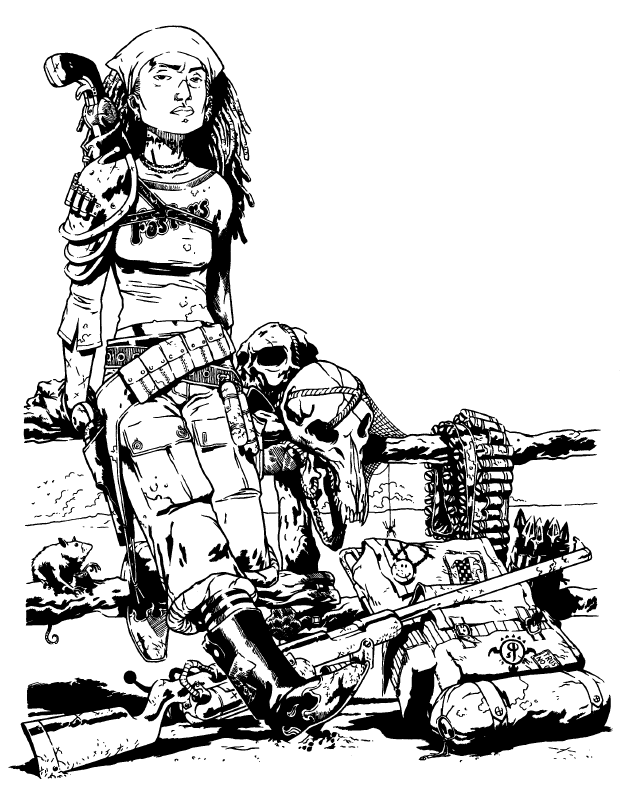
Sometimes I'm just like- "I have to include the one female illo from this chapter because there's only one."
- Jackaroo O.C.C. (13%): Another wilderness scout-type character. I think by now there are enough variations on that notion - we just had two, but they rough it slightly less than the Bushman. While originally a term for cowboy or rancher, these are supposed to be overall jacks of all trades (jackaroo getit), which is a nice way of saying they do nothing particularly interesting or well. They get a unique "prospecting" skill, which I guess is useful if you're playing a campaign based around Australian mining. (You're not doing that, though. Let's not even pretend.)
- Merchant Trader O.C.C. (39%): A wandering merchant or an agent for adventuring group, we're referred to Rifts Mercenaries if you actually want useful numbers to work with. They're supposed to be well-educated townies, and get skills to evaluate goods, gems, and metals, a miniscule chance to call upon contacts, and a bump to social stats. They actually get a broad array of skills, leaning towards the academic side of things. Nothing special, nothing awful.
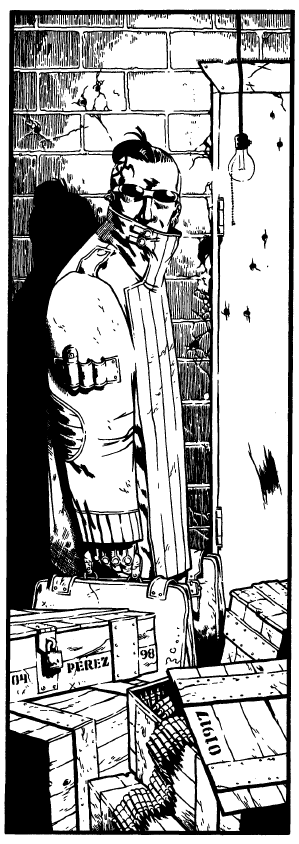
Shady merchant or flasher?
- The City Trader O.C.C. (7%): This is the rare sort of merchant that has an agreement to be allowed to trade with one of the walled cities of Perth or Melbourne. In return, they have to often act for the benefit of the cities, like spying for them or arranging deals on their behalf. If working for tech-fascists sounds like an evil act, that's because it almost certainly is. They have to roll to see if they're an Outbacker that cut a deal with a city (likely), a down-and-out city dweller trying their luck on the outside (unlikely), or some outsider to the whole political situation (rare). Essentially, they're a Merchant Trader -skills +contacts.
- Outbacker Runabout O.C.C. (23%): What if Jackaroo but more of a drifter but practically the same mechanics (including the rope works and prospecting skills) what if what if.
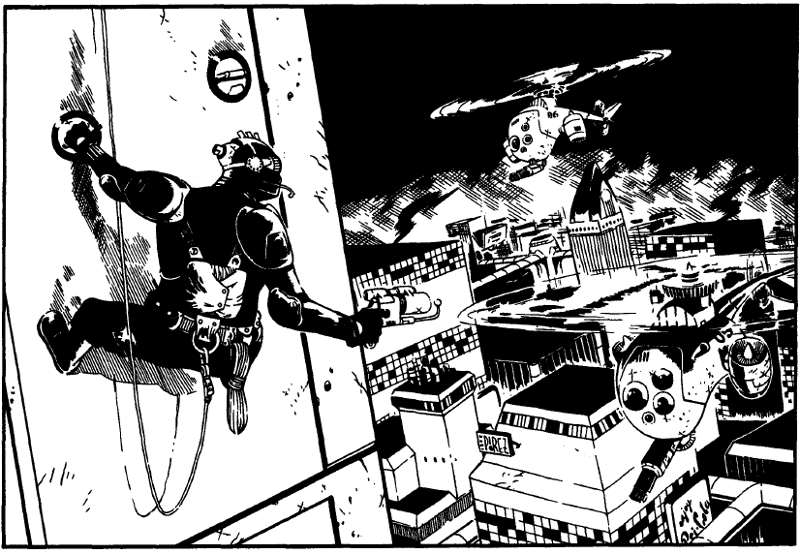
Seemed like a good plan at first.
- Raider O.C.C. (15%): These aren't just generic roving bandits- specifically, this is a class about thieves that specifically target Perth or Melbourne to sneak in and steal shit. It's extremely dangerous, but also extremely profitable if they can find a buyer. As a class, they're pretty solid sneaky sorts with an initiative bonus. Neat idea, I can see translating it to America with the Coalition or the like. The class itself isn't amazing, but the concept's a start.
- Roadganger O.C.C. (63%): For your aspiring War Boys and Dreadnoks, these are probably what most folks thought of when they saw "Raider" above. We get nearly a half-page of handwringing if you play one everybody's gonna hate you and you're probably a jerk. They get some decent bonuses to fighting from vehicles (or, at least, a lack of penalties) but are pretty one-note skill-wise.
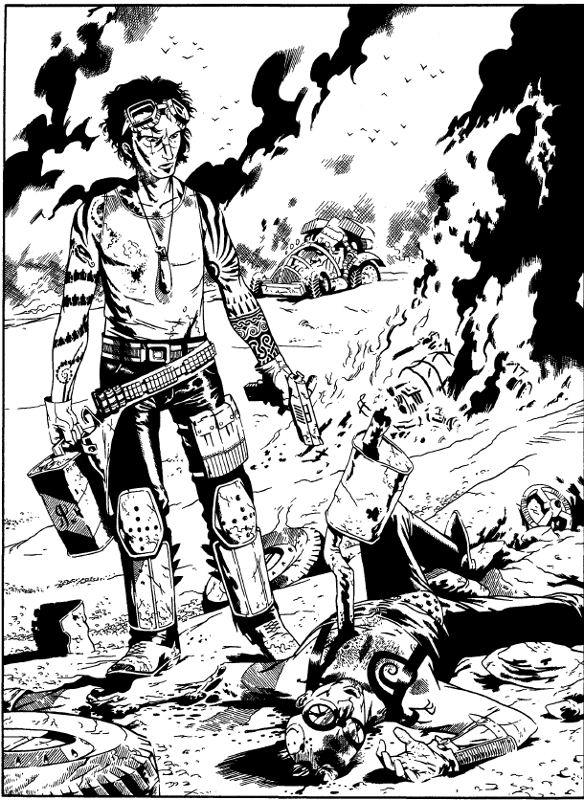
"... I'm not... going to pay a lot... for this muffler..."
- Road Sentinel O.C.C. (37%): my pc's name is jax jazzonoski he's like mad max but has green eyes and long hair and he hates bad guys and runs him over with his car but it's not a car it's a monster truck and it shoots fire and the bad guys are like its society but it's not society they're just bad die bad guys die (Gets some dodgy abilities to shoot while driving and bonuses to roll with the impact in a crash. It really is three-fourths of a page trying to describe that there are many Mad Maxes driving around but never why. There just are, deal with it.)
- Sham-Man O.C.C. (55%): "a.k.a the False Sorcerer" or "the false white man shaman". Sham-man, getit? These are non-indigenous people who managed to feel the tug of magic when it returned, and thought they could become shamans, but they can't, because ancestry. Some are cultural appropriators, while others are genuinely trying to learn the local Aboriginal ways. They're effectively bad versions of Ley Line Walkers, who trade away some abilities, access to high-level spells, and increases in spell strength. What they get in return as a bonus is the sense supernatural evil power of the Mystic and a "Spiritual Chameleon" power that lets them try and fool spirits into thinking they're indigenous... but that ability starts at under 25% and only increases by 5% per level, which means it doesn't start looking better than a coin flip around 6th to 8th level. Otherwise you piss them off. Whee!
- Songjuicer O.C.C. (53%): "The Songjuicer is the second type of White Wizard exclusive to Australia." This is a sorcerer that pools magic in themselves through a ritual, and makes them stronger and healthier, and well as later making them mega-damage and super-strong. However, they eventually age rapidly and have their magic deteriorate until death. This is all level-dependent, where they peak at about level 7 and go downhill from there. They can detox with the help of an aboriginal shaman, but lose all their magic save for being mega-damage and minor physical bonuses. The fact that they're level-based is a better balancing factor than your normal juicer, but you're still unlikely to face consequences in the course of a campaign. Otherwise, they're fairly average spellcasters, being limited by level like most non-Ley Line Walker spellcasters.
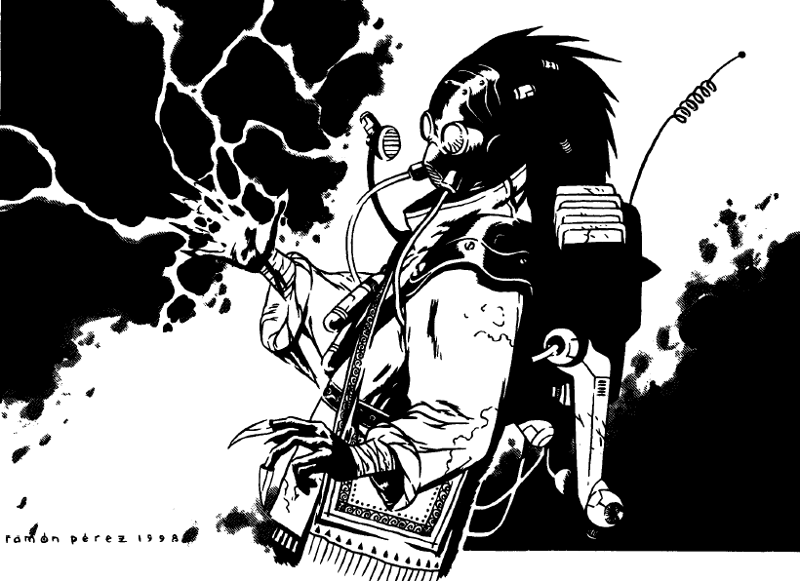
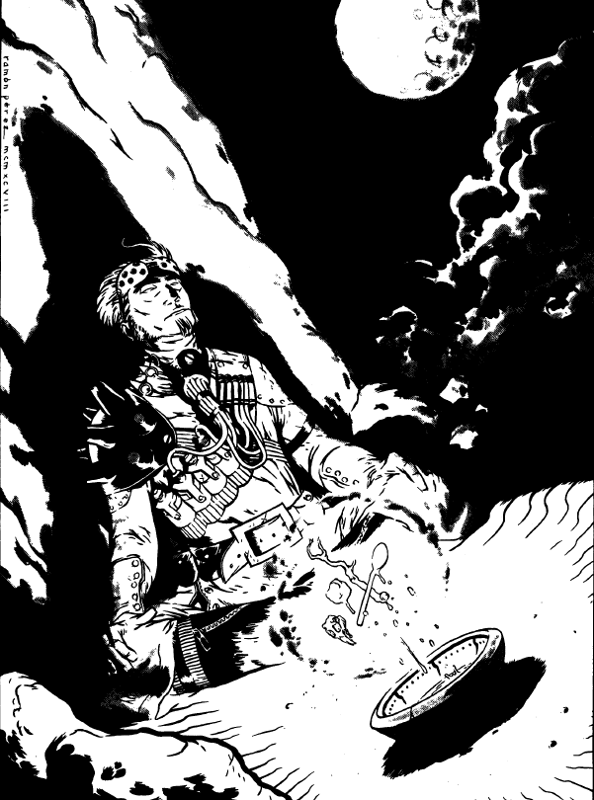
White wizards.
We wrap things up with the long list of classes you might use in the Australian setting, and they suggest reducing skills for some classes to reflect the local lack of education, just in case you felt the Euro-Juicer would be too storng. There are references to "Aboriginal" and "Reef" O.C.C.s not in any book. The only really common magic O.C.C.s other than those listed above are Mystics and Shifters, with Ley Line Walkers and Techno-Wizards being practically unheard of. Cyborgs are rare, and full cyborgs, juicers, and crazies are nearly unheard of outside of rare experiements. Psionics are as common as anywhere, but registered in the "tech-cities" and often expelled or executed if their powers are deemed too dangerous.
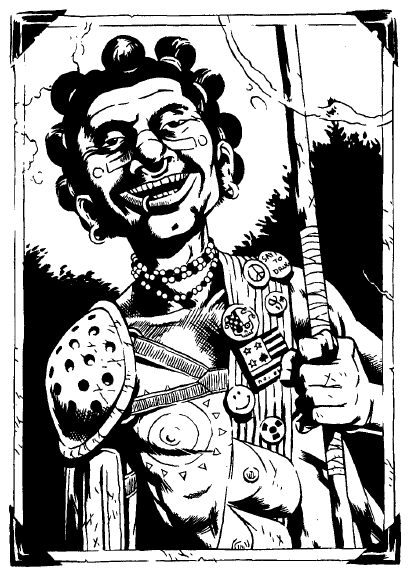
"None of my fellas wanted to be a guide, but joke's on them, I'm an O.C.C. now!"
Rifts World Book 19: Australia posted:
Where are the Aboriginal O.C.C.s?
Aboriginal O.C.C.s and information about their life style, dreams for Australia, Tribal magic and other types of magic will appear in Rifts® Australia Two: Mystic Australia. This 160 page World Book will also include more information about creatures of magic and legend, and other good stuff. Available summer 1999.
Mystic Australia will be followed by Rifts® Australia Three: Dreamtime, a walk inside the mysterious parallel dimension of magic and spirits, plus more information about spirits, magic, the aboriginal people and Australia. Probably a 160 page World Book available the fall of 1999.
Nope.
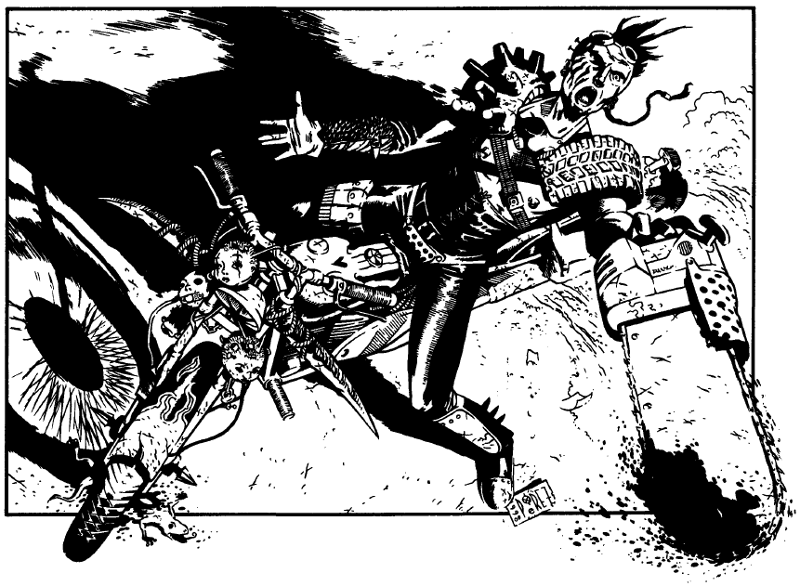
"Shake my hand?!"
It should also be mentioned that equipment is a little odd this time around. Since this book is presuming a somewhat lower tech level for Australia, M.D.C. armor ends up being harder to come by. Most of these classes only get "homespun" M.D.C. armor, which means it doesn't offer complete protection. On a high enough attack roll, this armor can be bypassed - which is basically instant death if you're facing M.D.C. attacks. Moreover, some classes, like the Sham-Man or Songjuicer get no M.D.C. armor at all. While presumably they can use spells as protection for periods of time. This wouldn't be a problem if most enemies you faced used S.D.C. attacks, but as we'll see, most of the bad guys and monsters get unfettered access to Mega-Damage weapons and attacks.
We'll talk about that more in the equipment section, but survival ends up being an even larger issue in this book than it usually is.
Next: Vires acquirit eundo.
"This impressive machine is fondly dubbed 'Big Brother' by lower level citizens, because it watches and records a lot of public activity, like something from a political paranoid's worst nightmare."
Original SA post
Rifts World Book 19: Australia, Part 5 - "This impressive machine is fondly dubbed 'Big Brother' by lower level citizens, because it watches and records a lot of public activity, like something from a political paranoid's worst nightmare."
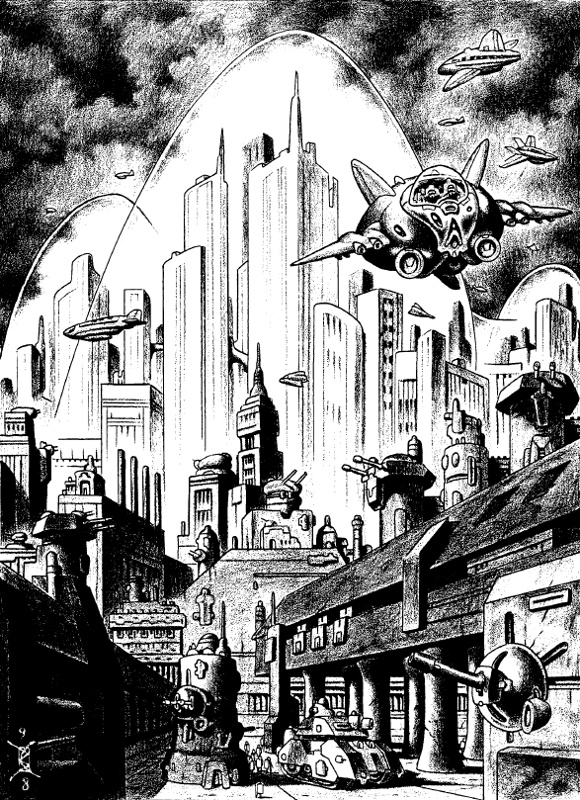
After the Jones family got a turret, well, just everybody had to have one.
City Blueprints
A Tale of Two cities
As previously mentioned, Melbourne and Perth were the only Australian cities to survive the apocalypse, and have worked to fortify and isolate themselves ever since. They're not allied in any sense - they haven't even made meaningful contact - but they share a lot of similarities. While their societies are highly advanced and affluent, They're also highly regimented and bureaucratic. They generally see the outside as a hellscape overrun by bandits and monsters, and ban immigration almost entirely.
Melbourne
Now located on an island thanks to the flooding during the cataclysm, Melbourne is entirely walled off and though there are ruined beaches, no citizen visits them. In general, it comes across as a large steel and concrete monolith, with aircraft constantly patrolling for dangers.
Melbourne is technically a democratic republic, but is given to severe jingoism and the military wields a great deal of power. We get a long list of governmental departments from the Occult Investigation Agency to Department of Goods Distribution, but they all answer to the CAO, or Central Administration Office. There is no single president or prime minister, but the CAO instead is a committee of eleven representatives.
We get some quick places of interest: The Government Tower is a giant silver needle that houses most of the major goverment offices within a perimeter wall. The Botanical Gardens take up a fifth of the island for hydroponics and bio-domes to serve their food needs, with much of the remainder taken from the sea. The Football Stadium still exists because this is Melbourne and football is still important. Presumably they have several teams now, so it's not like "And the Melbourne Devils face... nobody! Again! Win by default for the Melbourne Devils! Hooray!" The Theater Zone is the main entertainment hub by happenstance. Lastly, The Energy Loop is a tremendous massive pipe that handles power distribution. Please don't blow up our large obvious power source! Please?
The city also has a central AI known as "MAC-2 Melbourne", aka "Kay", who helped advise the reconstruction and espoused the isolation that Melbourne lives under. While it has no technical authority and is theoretically an advisor, it spies and collects information throughout the city to provide to the CAO. It also handles important announcements and propaganda, and though an AI, still largely acts on efficiency and logic over feelings. Though nobody knows this for certain, there's a program where that if over 50% of the members of the CAO are unable to serve for any reason, it can take over the city by itself. There are conspiracy theories that it's seeking to overthrow the human government, but there's no hard evidence.
Perth
Though much of Perth was eventually submerged, the city had enough warning to evacuate. As they rebuilt, they built part of the city over the submerged ruins, and only built their major wall facing the shore. They make up the difference with heavy security and patrols, but they're debating whether or not to build that (sea-facing) wall. In general, it's more jumbled and less organized than Melbourne.
Government Hill is actually an island, and the main government have a pyramid-styled building. The Sprawl is much of the seaward area that struggles with flooding and waves, making it the closest equivalent they have to a slum. The Military Wall goes right up agains the mountains, but the bunkers and training camp that adjoin it on the inside make up the main military center. The Sky Needle was originally built for communications, but a lack of hope regarding the outside world has relegated its use to sensors and air control. The Monorail is a large rail system that dips up and down through the buildings. The Central Processor Plant desalinates water and purifies air, making sure smog is a minor issue. The Central Hydro Power Plant provides most of its power, though there are plans to build a backup despite protest from locals nearby. Lastly, the Center Domes are large, clear domes built to protect the citizens from air attack, airborne infections, and things trying to steal their... essence.
The computer that oversees Perth is the Black Swan PCC-12000, more commonly known as "Reflex". It mainly processes information and records, and anybody can access it, but with varying access depending on your "citizen level", whatever that is. It isn't an AI per se, though, and doesn't have any level of self-determination.
Features Common to Both Cities
So, despite being completely separated and out of contact with each other, both cities have common elements due to coming from the same society and same technology. And, you know, 300 years of development couldn't change that! You take two groups of people and separate them for 300 years, obviously when they come together they'll be like "well, not much has changed, do we still do fistbumps, we do, *fistbump*".
In the interest of avoiding duplication of effort, we get some mutually applicable facts. Both are fine places to live as long as you don't mind stifling fascism and surveillance in just about every place that isn't the bathroom (I'm just guessing they don't watch you pee, but I'm being generous). Every building and every room has its own address so that the computer can keep tabs on you. Everybody has a citizen card with a level designated between 0 and 5, where being caught without your card is a major offense. 0 is an unskilled laborer, criminal, or mutant, 3 would be a white-collar worker or blue-collar management, and 5 are CEOs, government administrators, etc. In general, the main way to improve your Citizen Level is by military / security enlistment.
Paranoia is a given, and fears of infiltration or invasion are common; hence the walls, citizen cards, etc. The walls are fortified with sentry towers, automated guns regular drone patrols, and they generally shoot anything that's larger than a cat without an ID card. Manned aircraft responses are also massively trigger-happy, and rarely give a chance for humanoid intruders to surrender. Everything else gets shot. Beyond the wall and above the city, there are "laser nets" of laser sensors that detect incoming intruders. While it's seemingly impregnable, there are ways to get in during gaps in laser net coverage (usually during aircraft or watercraft approaches), through pipes and waste chutes, etc. Basically, there's a guide as to how inventive PCs might be able to break in and out, though it's still fairly challenging.
Rifts World Book 19: Australia posted:
Oh, and G.M.s, you don't have to be generous, but be fair.
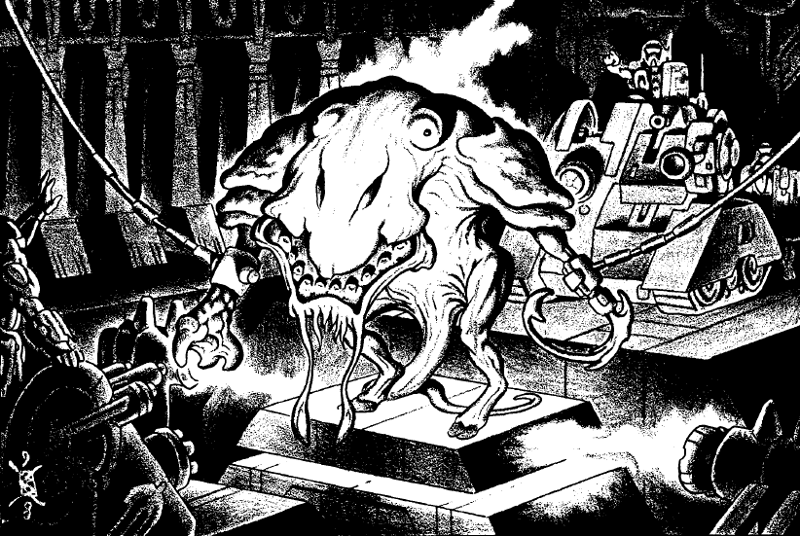
"Seriously, I was just looking for the loo."
Key Players
Police are straight-laced, heavily armed, honest fascists. However, crime is low, and most of their most serious threats come from the outside - smuggled items, magic, alien lifeforms, city raiders, etc. Murder and other major crimes aren't unheard of, but are very rare. They also deal with registering psychics and mutants, who are both considered to be dangerous by default. Perth is slightly more open than Melbourne, and has a result it has a slightly higher crime rate.
We get a list of crimes and punishments - more unusual crimes include wasting resources, hiding a psychic or mutant, illegal use of psychic or mutant powers, or magic usage. Imprisonment as punishment is unheard of- instead, one is typically given fines or community service. Major crimes can result in automatic conscription or loss of Citzenry Level. The worst crimes can result in temporary facial branding ("Humiliation Treatment"), "Personality Adjustment", or outright exile. Exile is the most feared, as citizens of both cities presume the outside is a terrible murderland (it is, but not as bad as they think).
There is a list of subversive groups, like organized crime ("The Collective", "Procurers Limited"), raiders, mutant rights groups ("The Mutant Liberation Movement", "The Mutant Defense League"), radical human supremacists ("The Supreme Australian Nation", "The Free Australia Movement"), fanatical isolationists ("The Anti-EHRA Movement"), and sorcerers ("The Secret Society of Magic").
Lastly, we end with a long laundry list of companies in each city, one of which are terribly notable beyond their spheres of influence.
Rifts World Book 19: Australia posted:
More details to come?
Of course, if Kevin and I had room in this book, we would detail plans for the cities, key personalities, villains, plots and schemes, as well as more equipment, vehicles, gizmos, world information, etc. However, this is an Australian World Book designed to offer a good overview, with some people and places focused on to provide background color and ideas. We're already planning a World Book that details the Aborigines and magic (Mystic Australia™), as well as a third book based on the Aboriginal spirit world and Dreamtime (Rifts® Dreamtime). Who knows, maybe one of these future titles will present more details about the intricacies of the cities. Both are fascinating topics that cannot be done justice even in this big, 220+ page tome. Hang in there as Kevin and all of us Palladium freelancers explore and define Rifts Earth... and the Megaverse.
Nope!

Next: Oh, the jerks you'll play!
"Consequently, any City-Goer made available as a player character, regardless of his O.C.C., can only be one of a few things: 1) secretly a City spy/assassin or other agent for the Tech-Cities, 2) an exile whose punishment has been expulsion from the City, typically a life sentence, 3) a criminal, 4) a terrorist/political activist/rebel or 5) an adventuring bozo who has a secret way in and out of the City without being noticed or missed."
Original SA post
Rifts World Book 19: Australia, Part 6 - "Consequently, any City-Goer made available as a player character, regardless of his O.C.C., can only be one of a few things: 1) secretly a City spy/assassin or other agent for the Tech-Cities, 2) an exile whose punishment has been expulsion from the City, typically a life sentence, 3) a criminal, 4) a terrorist/political activist/rebel or 5) an adventuring bozo who has a secret way in and out of the City without being noticed or missed."
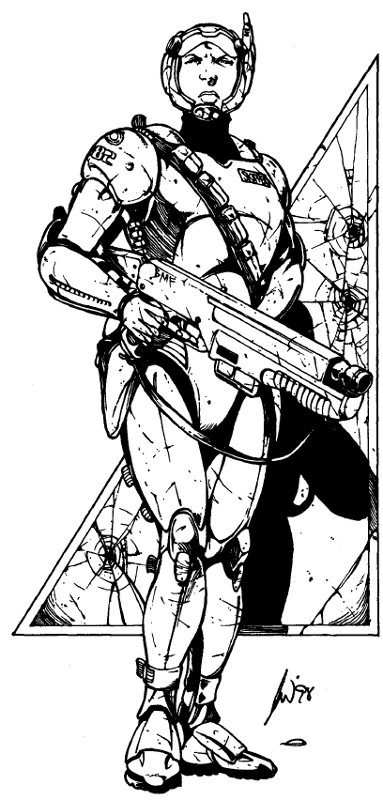
BMF = Big Mean Fascist? I can't imagine anything else it could stand for, really.
City Based O.C.C.s
Yes, you can play citizens of Perth or Melbourne under the above circumstances, or if you're part of a PC group affiliated with one of the cities. In other words, fascist sellouts. Well, they're still better than the Coalition, I suppose... but it emphasizes that most of the time they consider outsiders worse than animals. One thing I have to add, though, is even though I do make fun, I really like Michael Wilson's art here. He does a good job of making the classes look distinct and unique. I mean, the classes usually aren't distinct or unique, but the art is solid.
As always, the percentage is the amount of human PCs that will qualify for the class, given normal attribute rolls.
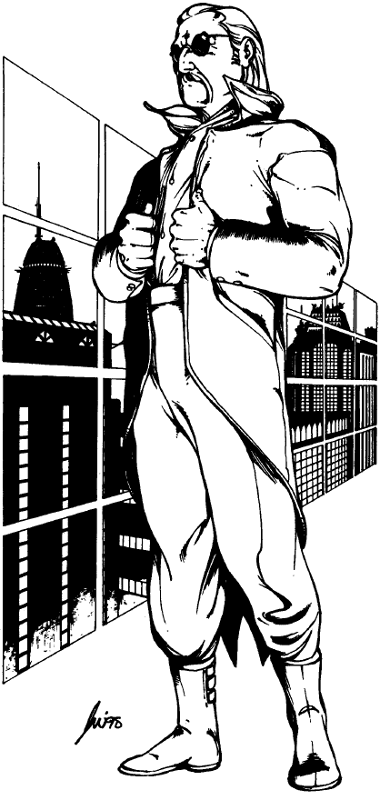
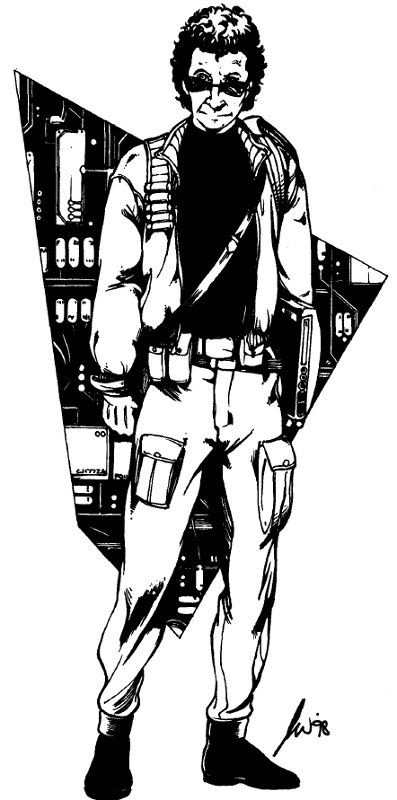
The Man and The Rebel
- Administrator O.C.C. (23%): This is a Level 5 citizen that's likely involved in a high position in business or government. It notes that PC administrators are more likely to buck the system or be characters that shake up the status quo, of course, and their main "ability" is that they have additional rights in their city others don't have - the ability to leave and reenter the city, use restricted technologies and weaponry, requisition personnel for tasks, or request policy changes. Otherwise, they get a lot of skills, though they lean towards the technical and academic sort. Also-
Rifts World Book 19: Australia posted:
No player character may ever be a member of the City Administration Office (CAO). No way, no how!
Rifts World Book 19: Australia posted:
Note: The Administrator can be a very powerful role to pass onto a player, and the G.M. is well within his rights to refuse to allow this character. In all, I feel it is best kept as an N.P.C. villain or powerful ally, but a campaign that begins in the higher levels of government and control, balancing the powers that spell the future of the last civilizations left in Australia, can be fun too.
- Cyber-Specter O.C.C. (28%): Apparently, the largest group of subversives in the cities are hackers, and you can play one, of course. These aren't particularly special in any way other than being particularly familiar with the security protocols of the city they come from. Unfortunately, rampant penalties mean they only have around a 30-50% chance to break a simple security program. Oh, you want to hack into the Central Computer? Be prepared to take at least several months to get a chance that's probably less than 25%. Basically, it's a skill that only really works in two places on the continent, and stinks. You stink. Nerd.
- City Police O.C.C. (33%): You want to be a jackbooted thug of the state? "City Police can make fun player characters..." We get a lot of details on the law code, where crimes are designated by number and letter and which ones get priority. (Grand Theft is prioritized over Rape, enjoy that part.) They get the usual dartboard selection of combat bonuses, a bonus to Affinity, maybe some cybernetics, and the ability to act as a Level 4 Citizen while on duty. Otherwise, they're fairly generic.
- Police: TRG O.C.C. (6%): Where TRG stands for "Tactical Response Group". These are essentially highly-trained and armed thugs that are sent into the Outback to investigate and eliminate potential and imminent threats to the city. A lot of this consists of just intimidating or eliminating nearby communities, and generally speaking they sound like a bunch of motherfuckers. They're mostly like police with a heavier combat emphasis, and get a choice in specializing in power armor or heavy weapons & demolitions. Not a bad class, if you don't mind being a murderous, brutal jackboot in human form.
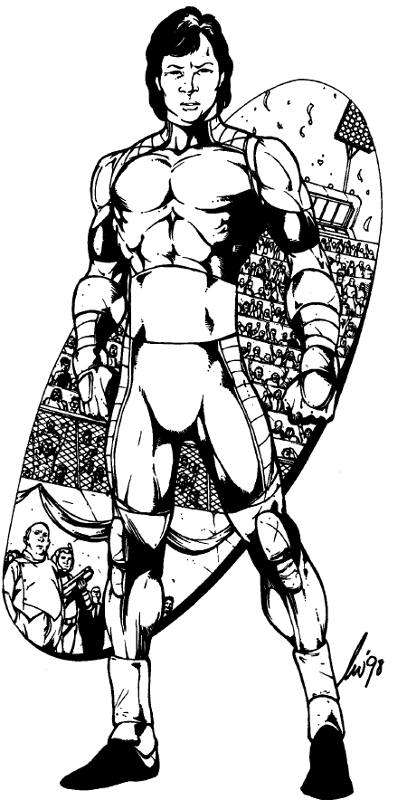
In the grim darkness of the far future, there is only sport.
- Sportsman O.C.C. (3%): Though listed in the city section, it emphasizes that this can be used for any Australian location, then emphasizes that most Outback "sports" are more just death games by Roadgangers and the like. Whiplash! In any case, you get to to be a physical powerhouse, but... that's of limited use given you're still at a human level, but your bonuses vary based on the sport you choose. Also, some of the sports seem odd given the setting. How is anybody practicing white water rafting in a closed city? Well, I guess you could use it for white water rafters in other parts of the world. You know, in... like... um... anyway. I presume Perth and Melbourne must have multiple teams for multiple sports, because they're not doing any away games or attracting any visiting teams. Which makes some sense because Australian football will probably never die. But are there really still bicycling competitions? We then get a list of sports still played, which includes stuff like arena combat or football (makes sense)... or cricket and tennis (even in the Outback?).
I imagine Outbackers pine for uninteresting days.Rifts World Book 19: Australia posted:
Cricket. A bat and ball sport similar to baseball (only a lot less interesting).
- Technologist O.C.C. (25%): Like the Sportsman, this isn't a city-exclusive class. It grants different skills depnending if you're a "city technologist" or an "outback technologist", but the difference isn't vast other than the fact the former gets some modest cybernetics. You get a lot of geegaw equipment, but ultimately this class isn't too different than the existing non-psionic Operator or Rogue Scientist from the core book.
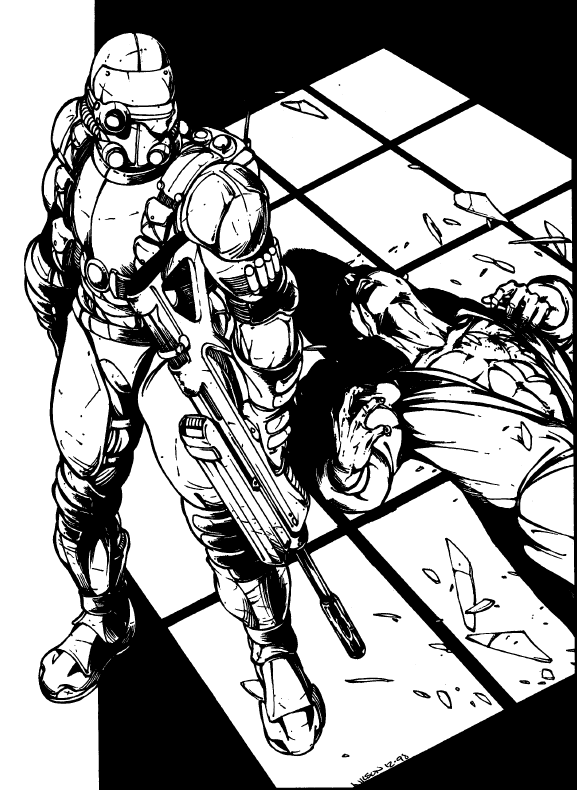
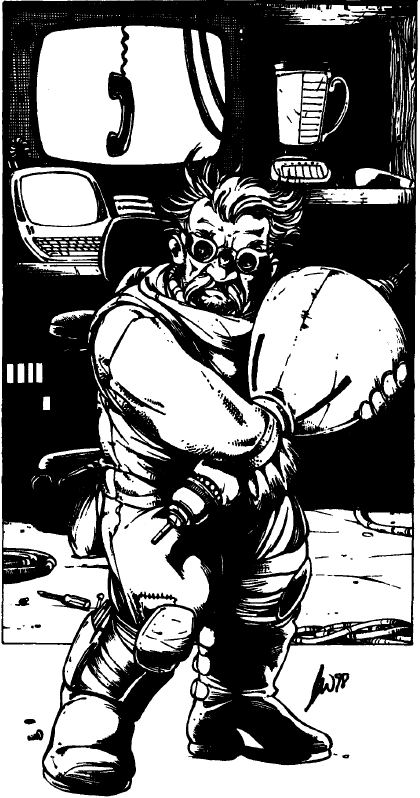
The Jackboot and... Troll from Youngblood, apparently.
Military Based O.C.C.s
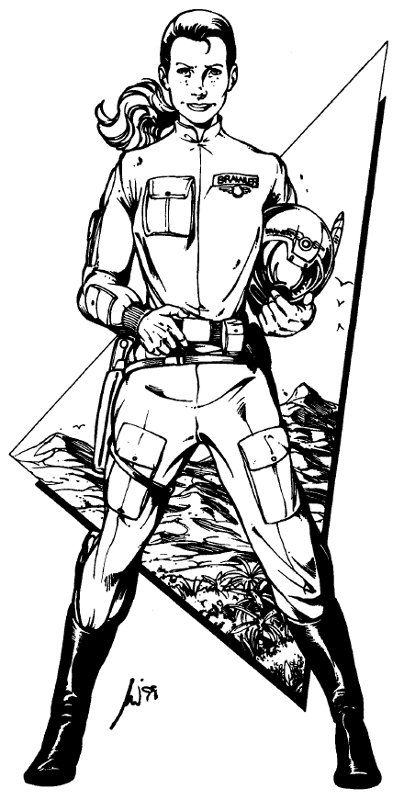
Loves the smell of napalm on the you.
I have even less to say about these. After the main book, Triax & the NGR, South America, Mercenaries, Underseas, Japan, Coalition War Campaign, Coalition Navy, and Warlords of Russia, what is there left to say about another mild variation on a set of military classes? The Aerojock O.C.C. (10%) is a pilot usually sent to patrol or air strike locations for tech-cities. They're institutionally bigoted, which no doubt helps when they're called upon for Bombs Over D-Bees. The Infantry Grunt (100%), Special Operations Soldier (3%), and Navy Sailor 25%) are nothing we haven't seen before. The Special Operations Soldier does nothing to justify its stiff requirements, and the Sailor can choose from a variety of specialities waaaait- The Navy Sailor is pretty much a copy-paste of the Coalition Navy Sailor! Well, knock a word off and you got yourself a whole new class, son!
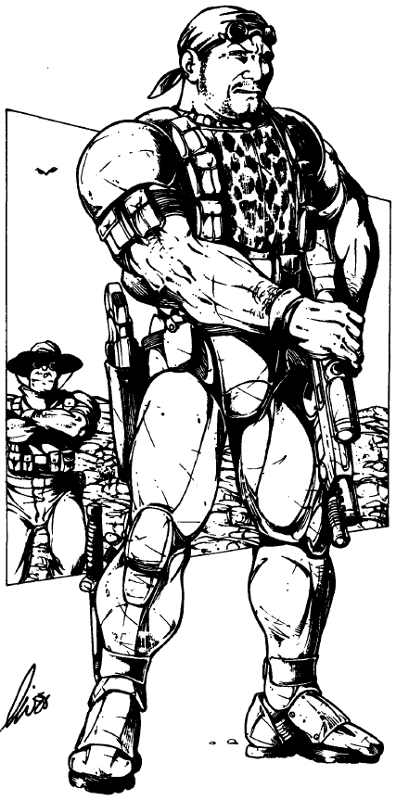
Clearly the leopard print is standard issue for G.I. Joey here.
Next: Humans and mutants cannot live together in peace.
"Natural Spell Caster with innate magical properties similar to Faerie Folk and other creatures of magic (also known as a 'Nate')."
Original SA post
Rifts World Book 19: Australia, Part 7 - "Natural Spell Caster with innate magical properties similar to Faerie Folk and other creatures of magic (also known as a 'Nate')."
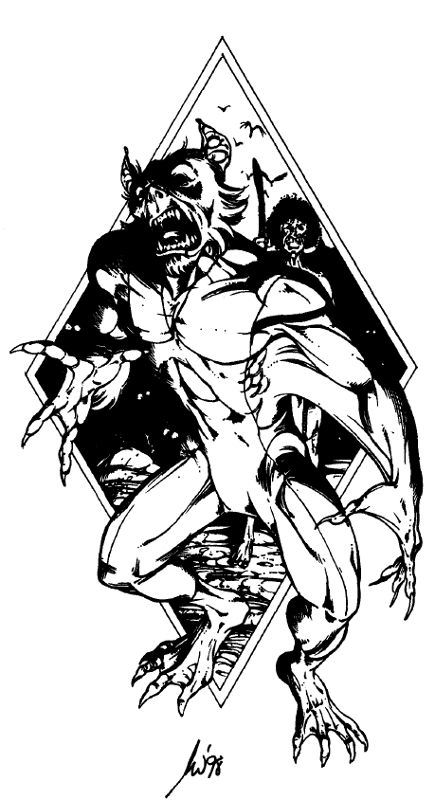
"SHAKE MY HAND?!"
Mutants
By Ben Lucas & Kevin Siembieda
So, while mutants were mentioned wayyy back in the original Rifts RPG, and hinted at but never included in books like Warlords of Russia, here we get legit mutant rules. The exact origins of the mutations is left vague - maybe radiation, a viral mutagen, magic, demonic meddling, etc. The Aboriginal peoples claim that mutations are blessings from being closer to the Dreamtime as chosen by the Rainbow Serpent, making people closer to "animal-like perfection". Many thusly work with the indigenous people, being valued by them. Others are corrupted by Tikilik, while some doing gangs or bandits to become known as "Phreakers", mutants who prey on the weak. Outbacks just call them "Muties", but the term isn't particularly derogatory. The term "Phreakers", however, comes from Perth and Melbourne, where mutants are treated as second-class citizens. Many join the military, where they at least escape a lot of day-to-day prejudice as they're often assigned outside the city - but face the biggest risks as a result. Ironically, many city-born mutants carry the prejudices of their origins and presume Outback muties are animalistic threats and menaces.
We get three tables mutants roll on: Physical Deformity, Special Mutant Powers, or Additional Special Abilities. Each says "pick one or make a random roll", so the odds of each result aren't terribly relevant.
The majority of results on the Physical Deformity table make you look like a specific animal, usually distinctly Australian: snake, koala, platypus, "feline", "canine", bat, kangaroo, lizard, bandicoot, tasmanian devil, thyalcine, or echidna. There's also looking like a tall skeletal person, third arm, or a mix of multiple animals (the latter of which seems to have no real in-game effect...?). Or you can just look normal. Furry alert: We're told 33% of canines get a special +8 to Affinity due to wolf charm. And if you get that bonus, you also get a special bonus to any one physical attribute. Ditto for felines, but the +8 is to Beauty instead. As a feline or canine get a choice of Thundercat or full-on Battle Beast, but either way you can be a looker.
To all the tasmanian devils and platypi out there, I just want to say: don't let Palladium tell you that you aren't beautiful. You're gorgeous just the way you are, even in this post-apocalypse world of feline and dragon-centric beauty standards. (Also, don't let a table ever call you 'Deformed'.)
Next is Special Mutant Powers, the majority of which are psychic power sets of various stripes. Other possible powers include very minor spellcasting, magic immunity, and becoming a super-strong mega-damage being (the former two convert one into a very-weak mega-damage being).
Lastly, you get one from the Additional Special Abilities, which are general advantages like getting a bonus attack, Intelligence, Strength, become M.D.C., get good at swimming or hiding or climbing or running, shooting lasers, or having wings- but none of it is connected to your physical mutation. So you could be a winged kangaroo mutant, a genius tasmanian devil, or a high-speed koala person. Mind, the fact you can choose makes some options redundant. Why become a Minor M.D.C. creature when you can become a Major M.D.C. creature? Why become a Natural Climber when you could have wings? Well, I guess they're penalties for the fools who opt to roll. Each has its own nickname, like "Zap-Sack" for a electrokinetic or "Magic Back Rounder" for magic immunity.
Then we get two new classes for mutants: the Outback Mutie R.C.C. and the Phreaker Military Grunt. Neither have any requirements other than being mutants, but it's not clear what classes mutants might be able to take otherwise (though it's possible to end up as a Mind Bleeder from Africa or Psyscape or a Mind Melter on the powers chart). Neither class is too unusual - the Mutie is a generic adventure and the Military Grunt is... another Military Grunt class. *grunt*
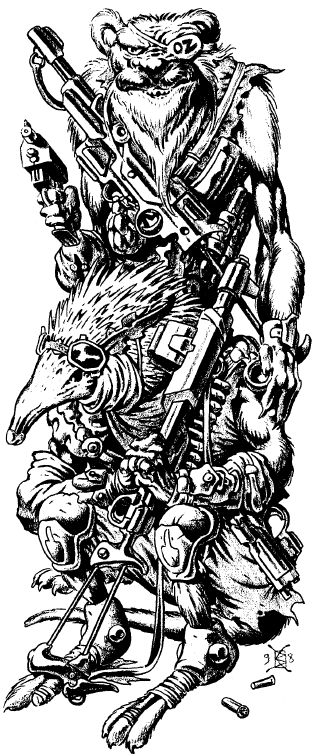
Ty and Knuckles get reinvented for the gritty reboot.
Lastly, there's a parallel to mention about the Australian mutants in this book and the Australian mutants in another Palladium book. The After the Bomb setting, in which animals are mutate after the apocalypse and come to dominate the Earth, had an Australian supplement called Mutants Down Under. In it, animals that had mutated were seen by Aboriginal peoples as spirits that had come to reclaim the Earth for the animals and- well, it's pretty much a direct parallel here, right now to some mutant animals working for evil human fascists (though in Mutants Down Under, they were Jakartans in blimps instead).
Next: Koalas vs. Crocodiles.
"As you can imagine, the koala-men were a fierce sight, drippin' blood from their claws, some of em carryin' weapons."
Original SA post
Rifts World Book 19: Australia, Part 8 - "As you can imagine, the koala-men were a fierce sight, drippin' blood from their claws, some of em carryin' weapons."
Optional Player Races
It's time for things to go full Rifts.
Kwarla R.C.C.
Optional Player Character R.C.C.
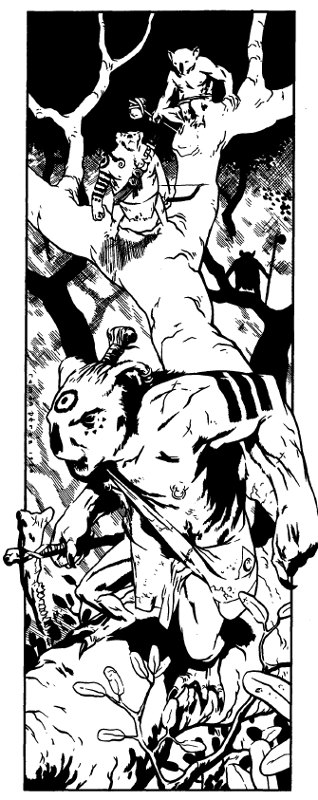
When will you rage?
Yes, it's not enough to just have people who have mutated into half-koala people, let's have people that have been transfigured into half-people koalas. It's a Megaverse™ of options! Supposedly there are a number of native animal spirits in Australia, and the "The Great Koala" passed on his koala rage onto a group of humans to help them survive in this new land, making them into magical koala people. Also, he wanted to pass on his koala rage so he could koala nap instead. No, seriously, that's not exaggeration or a joke, that's the actual reason.
The Kwarla are stocky four foot humanoids who build Ewok-ish tree communities. They're apparently allied with the Millennium Trees, which presumably were intended to be detailed in Mystic Australia, but that never happened. They have regressed to the wood, stone, and bone level of technology, but are mega-damage creatures. They're curious, buff Ewoks with a kind disposition, but they're go full wookie on demons and other creatures of supernatural evil.
An interesting note is that they down't really understand lies or deception and are brutally honest at all times. Unfortunately, Palladium editing rears its shrouded head in agony! It says that "guile and deception are alien to them" but then goes and says "Kwarla are masters of the ambush". Crikey, make up your mind! For whatever reason, they have strongly gendered roles: guys get to be demon hunters or mystics, while "all females are providers". What's a provider? Gatherers and housewives, more or less. But supposely one tribe has one female that's one mystic! That's progessive!
As a mega-damage species, they're a bit dim, but very strong-willed, strong, agile, and tough. They can climb very well, ignore vampire mind control, power up with aura that triples their mega-damage, have claws they can animeify by calling upon their "Claws of Vengeance!" and then do suprisingly solid damage against the supernatural (but not against the technological). Males get physical psychic powers, while females get sensitive and healing powers. They have a default "Demon Hunter" R.C.C. that's a master of the wilderness and does some combat, while female Kwarla have the "Provider" variant that's essentially the same with more domestic skills instead of fighting skills.
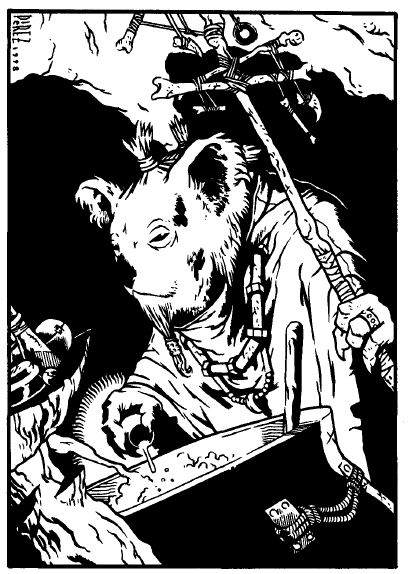
"Koala! You seek Koala."
Finally, we have the "Kwarla Mystic" R.C.C., which is similar to the existing Mystic class from the corebook in that it's kind of a half-assed master psychic and half-assed wizard, but also gets the ability to do very vague divination a number of times equal to (level per month). Seriously, it says "The G.M. should answer the questions as vaguely as possible..." so it's an ability that exists at the GM's sufferance. They also get the favor of Millennium Trees and other "Millennium Entities" (it's said that the Great Reef is one, but this remains undetailed due to - once again - the lack of a Mystic Australia). While they get bonuses to their endurance (both) and mental attributes, they don't get the magic aura or claws as a result. Or, at least, I think that's how it's supposed to work. It's not clear. Palladium editing!
The Mokoloi
Reptile Men of the Northlands
NPC Villain & Optional Player R.C.C.
By Ben Lucas & Kevin Siembieda
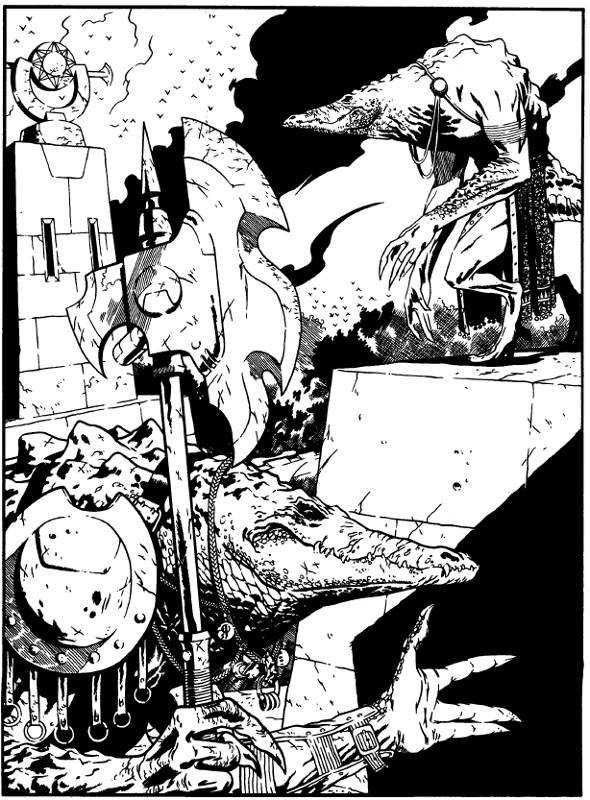
"Come see our scenic stone blocks!"
So, we already had Tautons and Crocodilians in Africa, but why not add on another race of crocdudes? Why not go mad?
Originally the Aboriginal peoples thought these were a blessing of a crocodile spirit, like the Kwarla, but it turns out that they're D-Bees from another world. They lived on a swamp world hundreds of light-years from Earth, and developed an advanced civilization that used magic and technology. However, their technology was dependent on "the properties of water", and when a mysterious geological disaster dried up the planet, their civilization collapsed along with it. However, a number of them saved themselves cyrogenically, and a Mokoloi wizard found these preserved remnants and warped them to Earth, dying with the strain of the spell.
The survivors see this as a second chance to rebuild their empire. Some have journeyed outward across the sea, not to be seen again (some have created settlements in Southeast Asia), but most are located in the Northlands of Australia. They're deeply religious and debate why they ended up on Earth incessantly. Ultimately, though, they're trying to reinvent their society and relying far more heavily on magic than they used to.
Though oligarichal, they're also matriarchal and men are slightly disadvantaged in society. They're a very strength-focused society and exile the old, severely sick, or those with a disability as to not have them be a "burden". Well, at least they don't eat babies.
They tend to be prejudiced against "mammals", and encounters with raiders and tech-city scouts haven't helped matters. In addition, they're generally somewhat paranoid due to their own insecurity, and quick to try and assert their dominance. However, they have a strong sense of debts and will likely to ally with those they believe they owe. They're not just relentless invaders, even though they believe Australia to be their "chosen land", and haven't expanded too quickly. However, they do believe that humans will eventually need to be driven out. They've somehow gotten a burgeoning alliance with the ordinarily isolated Horune Pirates (from Rifts World Book Seven: Underseas), some of them even joining up for a pirate's life. It emphasizes they have a high rate of birth, though, and likens them to other invasive species.
As a racial character class, they're minor mega-damage creatures with overall high attributes (save for beauty), with strength and physical endurance being the highest. They're semi-aquatic and need to be immersed about every 48 hours or suffer penalties, and they might even die if left outside of water for months. Males (and only males) get a special martial art that gives them more damage, a special crushing grapple does damage directly to hit points (if you're not mega-damage), and a "roll-over" attack where they grapple you and roll over and over. This does damage as per the crush, and makes it really hard to escape the grapple, nearly ensuring death to armored humans as they take an average of 31-32 damage directly to HP every 15 seconds if they don't break free. (A level 6 average human will have 31-32 HP). Females get a broader selection of spellcasting classes and scholar classes, while males are mostly combat classes. It notes you have have to adjust skills / equipment of existing classes for them, but doesn't say how.

Is that a handle next to the barrel ports?
Mokoloi Technology & Equipment
While they've lost most of their native technology, the Mokoloi have reinvented a fair amount of it. In addition, they have Stone Magic and ley line harnessing pyramids, but are loathe to share any of their technology because fuck you, PCs, you ain't gettin' none of this!
All of their weapons have neat alien names that make them tricky to sum up or pronounce like "Arl Wrl Kim" or "Maa Rohk Cra". Their weapons are techno-wizard tech, like a "Constrictor" Web Gun that shoots magic nets, a "Knuckle Duster" that makes crappy punch lightdaggers that can also be fired off, a Lava Gun that does middling damage to a target and very minor damage in a "splash zone", and a "Warrior's Blade" - a barbed sword that does minor mega-damage, and magically returns after a toss. They also have explosives that are just reskinned human explosives.
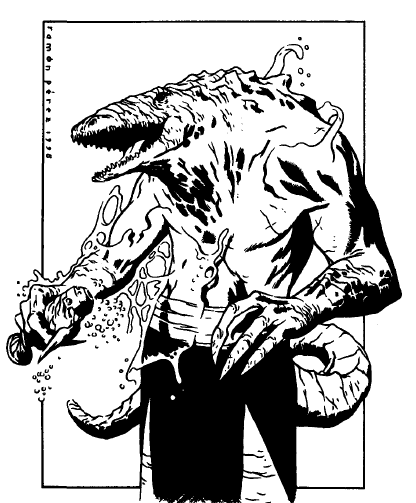
Armor: now in a convenient squeeze tube!
Then we get armor for them as well. The "Snake Back" or "Wrap" Armor (60-90 M.D.C.) is a techno-wizard goo that wraps around the body to become an near-invisible skin around its wearer (and clothes, if left on before application), and flakes off like snake skin when damaged. We also have the "Prey Stalker" Combat Powered Armor Suit (280 M.D.C.), which is overloaded with weapons - flame gun on the back, "lava launcher" in the mouth, silver mega-damage blades on the arms, and concealed... sonic blast weapon, concealed eye lasers, and a concealed electric zapper. Granted, the only ones you need to use are either the flame gun (21 M.D. average) and the sonic blast weapon (knocks people over).
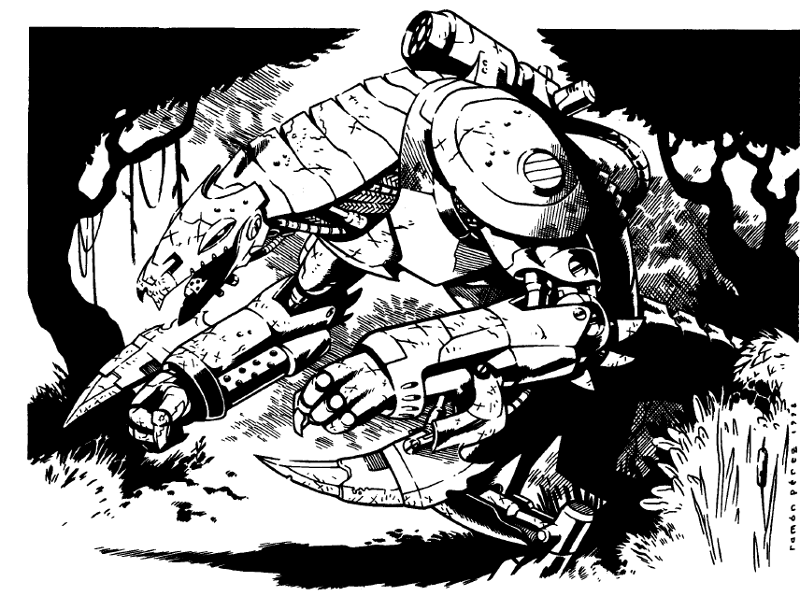
"I'm a stalker, but not a stalker. Don't get it twisted!"
Shadow People R.C.C.
So, this is a race that existed on Earth in ancient times (whether or not they're native to Earth is unclear), but were put to sleep by the fading of magic. They had good relations with local people in ancient times, and after their reawakening they reestablished good relations with the Aboriginal peoples since they're like "Oh, you're still around!". Which actually makes sense! A small breath of fresh air compared to the "they like native peoples because it's a mystery!" that Spirit West fell back on every time.
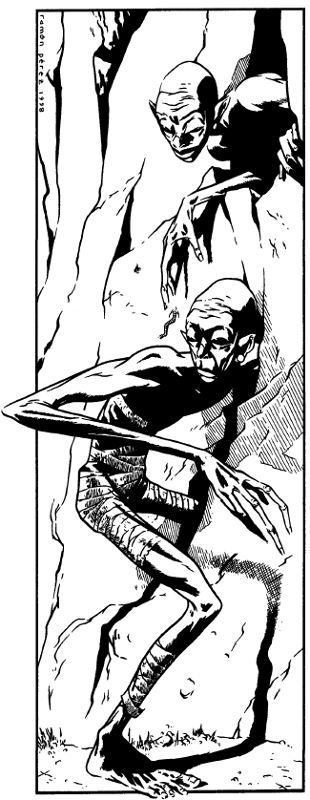
"Th-this is my hole! It was made for me!"
Though cripplingly socially averse, they are highly curious and have a tendency to sneak around and spy on people. They're also generally benevolent and try and help folks out and stop evil when they can. They generally rely on magic, only having basic tools. They tend to live inside a a pocket dimension of well-lit caves that they can only enter through cracks in large rocks and rocky surface, and if the rock is broken, their home is destroyed and they're ejected. PC ones are noted to likely be more outgoing and curious than most.
As a class, they are weak-willed and not very strong, but have a high affinity and get to be very minor mega-damage creatures. They have a number of magic powers, like hiding in rocks, becoming a 2d image that can slide around surfaces, and become less visible in shadows (to being invisible in total darkness - though that seems like it'll be academic with many characters). They get a variety of wizard or temporal magic spells (from Rifts World Book 3: England), but they lose their natural powers around ley lines and ley line storms.
Next: Your life hangs on the buzz of a didgeridoo.
"In all cases, opponents are at -2 to parry and dodge boomerang attacks, as they are highly unpredictable missile weapons difficult to avoid and defend against (trust me, I know from experience)."
Original SA post
Rifts World Book 19: Australia, Part 9 - "In all cases, opponents are at -2 to parry and dodge boomerang attacks, as they are highly unpredictable missile weapons difficult to avoid and defend against (trust me, I know from experience)."
Skills For Down Under
So, we get a new skill section once again, and one of the issues with these - aside from all the usual issues of skill bloat and paltry starting chances of success - is that some of these have become "standards" for new classes, so they keep having to reprint them literally every two books or so. So a lot of these skills are "new" in that they aren't in the corebook, but have appeared before or even several times before in other books. For example, all of the "Cowboy" skills from New West are reprinted as "Aussie Cowboy" skills. Many other skills from other books are reprinted, including such stars as Basic Mechanics, Dowsing, and Breed Dogs.
Weirdly, there's a note you can't learn any of these new skills without spending time in Australia unless you spend 7-12 months in the country, which might make sense for something like Lore: Dreamtime, but not so much for W.P. Spear or Whittling. Yes, of course Whittling makes an appearance. It's an
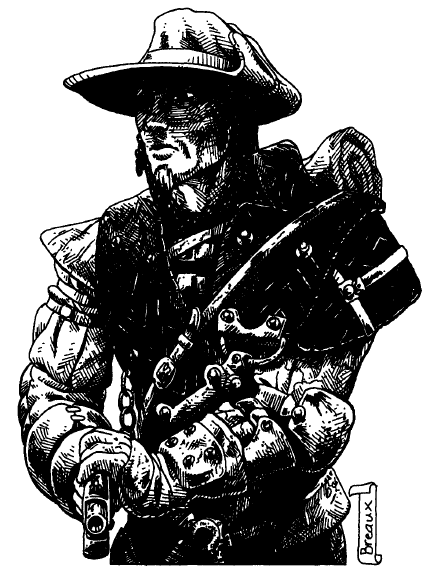
"I'm here to whittle and kick ass, and I'm all out of wood."
Sooo let's go over some of these new skills. Not all of them. I have some mercy.
- Corroboree: This term references traditional dances done by Aboriginal Australians, but in Rifts World Book 19: Australia, it instead refers to a dance used to contact the Dreamtime. The actual term varies by region, but that's not a complexity for a Rifts book to touch. In any case, this can be used in place of meditation to improve your recovery of magic or psychic power, but given meditation has a chance of 100% and this has a starting chance of 30%, which would you do?
- Play Aboriginal Musical Instrument: Yes, we already have a Play Musical Instrument skill, and yes, it already requires you to select a specific instrument every time, and yes, we could have just added those to the list of existing instruments. But playing a didgeridoo is hard, man! It requires a lower than usual chance of success - 25%. Also, a bush whistle is... really... I mean, not really as hard, and beat sticks are just... sticks... but they get the same lower chance, because they're exotic? I guess? Is it really important to have a PC that actually invests in playing a didgereridoo stink at it anyway? How often will it come up? Will you end up in that situation where the chief is like "Kill this fool!", and your only chance of survival is to blow their minds with that sweet breath of didgeridoo buzz?
- Outback Combat Driving: This doesn't have a % of success, but reduces the penalties of tricks and maneuvers by half!... too bad all the vehicle combat rules are in different Palladium games, huh? Well, it at least gives you some other combat bonuses.
- Road Train: This a specific skill for four or five linked trailer vehicles used to cross deliveries across the Outback. Pretty cool! Also, road trains are not mentioned anywhere but this skill. Yes, you can drive a thing that may or may not exist!
- Water Skiing and Surfing: Surf Coalition Must Die.
- Languages: All Indigenous Australian tongues are lumped together under "Aboriginal", but at least the game acknowledges this as a simplification, and suggests a penalty if you're far away from where you originally learned it. Kwarla and Mokoloi get their own languages (Shadow People just speak Aboriginal). And we also get "Australian English"
 which is compatible with American at a penalty of "1d4 x 10%". City dwellers just speak regular English.
which is compatible with American at a penalty of "1d4 x 10%". City dwellers just speak regular English.
- Lores: Of course, we get to split the infinite further by adding lores for "Aborigines", "The Cities", and "Dreamtime". Knowing about the Dreamtime is supposed to be very special and haaard if you're not indigenous. It also gives a very vague outline of the Dreamtime, which we'll get to hear more about in Rifts Australia 3: Dreamtime! I'm sure it'll come out someday.
- Outback Survival: Like Wilderness Survival, but Australian. Yep.
- Roadwise: You know where roads go.
- Use Songlines: Aka Ley Lines, this allows you to tune into Ley Lines with song and dance, and do things like get a feel for the terrain, learn about important events in the area, find caches flagged by other Songline users, find water, detect distance, and send stories to recipients down the line. Wait, what dance do you use for this? The Corroboree? Isn't that already a separate skill? Well, don't look for a clarification here!
- W.P. Boomerang: This gets over a half-page of effects and stunts you can pull with it, like throwing a boomerang so it catches them in the back, or to fling at the ground and have it fly up at somebody, or whatever. All of it's pretty neat! Wait, which weapons use this proficiency? Just S.D.C. weapons? Nothing that does Mega-Damage? Hahahaha... well... it sounded neat.
- W.P. Flamethrower.: This is mainly a collection of new rules for flamethrowers, such as them bypassing non-sealed armor or inflicting horror factor. Well, given the low damage of flamethrowers in general, they could probably use the help.
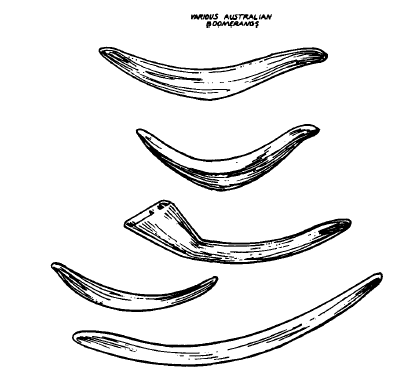
Pretty sure this art is from one of the earlier Palladium "weapon compendiums".
A number of these are taken from the After the Bomb supplement Mutants Down Under, which is how we get a ultra-detailed W.P. Boomerang skill even though there are no mega-damage boomerangs. Well, I guess over a hundred skills is never quite enough.
Next: It's adorably destructive.
"They also believe that some of the demons are attracted by the thoughts, fears and foul emotions of whites and D-Bees."
Original SA post
Rifts World Book 19: Australia, Part 10 - "They also believe that some of the demons are attracted by the thoughts, fears and foul emotions of whites and D-Bees."
Monsters and a Few Animals

Look, you've drawn one giant penis monster, you've drawn them all.
Our first monster is the Desert Worm (110-360 M.D.C.), which fulfills the trope you'd expect for the post-apocalypse as a several hundred-foot worm that lunges out of the sand to try and snag people for food. It can swallow people whole on a crit, and the timer starts to see if you can shoot your way out in time (which isn't hard). The only real issue is that if it swallows a human unarmored, they die in 1d4 rounds regardless of their actual toughness. They generally retreat if attacked and try and ambush later, but don't push their luck too far- they're not really aggressive enough for an extended combat.
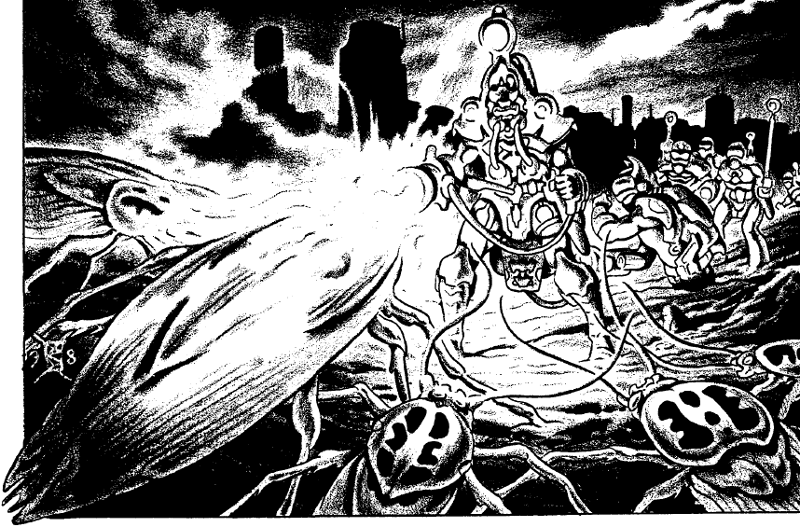
Being an future exterminator is way more Kirby than I expected.
Giant Cockroaches (0-8 M.D.C.) are two to twenty-five foot bugs, but they generally don't attack lively targets. They will, however, attack the weakened or helpless - roaches ate my baby! They're ultimately just S.D.C. creatures with their toughness and strength determined by size, where only the largest qualify as "mega-damage" just by having hundreds of S.D.C. points. Technically they have a "super-regeneration" power where they come back from death unless reduced below -30 hit points, but nearly any Mega-Damage weapon will do just that.
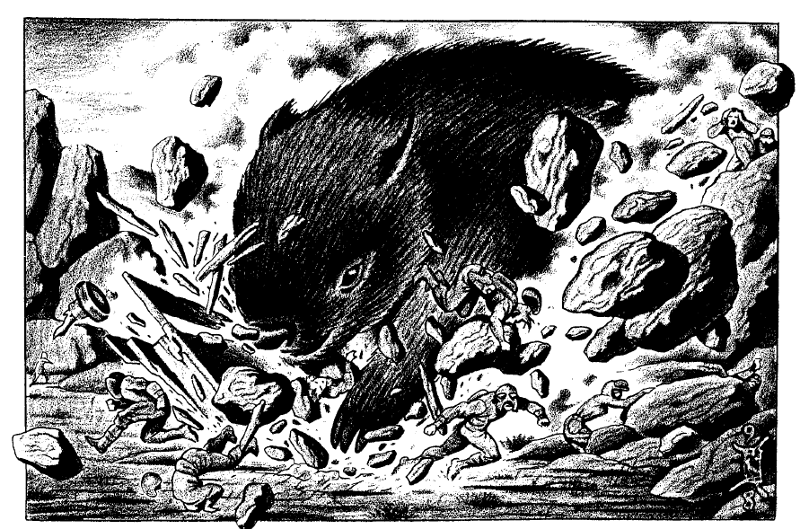
More like the 'Dawwwombat.
The Giant 'Dwombat (280-580 M.D.C.) is a 10'-40' mega-dmage wombat. Though herbivores, they're apparently hot-tempered and stubborn, and will often destroy crops or damage towns heedlessly. They won't eat or attack people, but hardly care if they run them over, either. Its origin is uncertain, but it seems likely to be a result of mutation caused by radiation, magic, or both. Also, they're adorable.
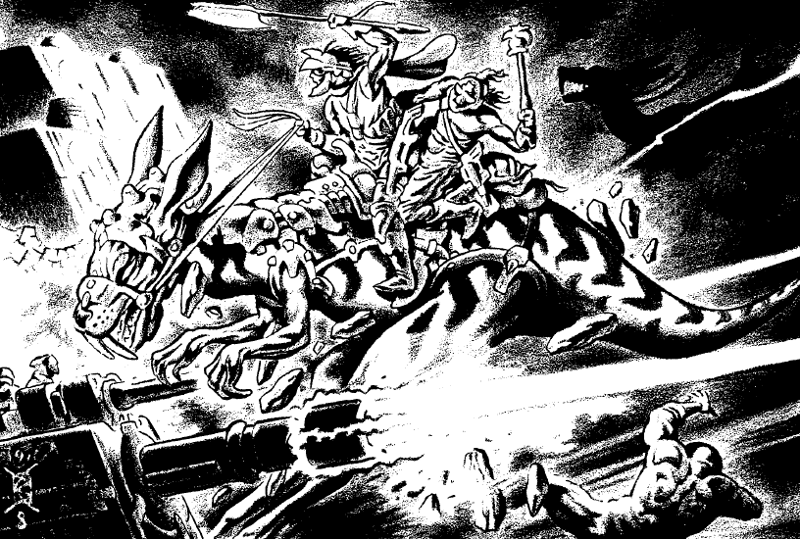
Night of the Leapus.
Though it seems like a kangaroo at first glance, the Giant Kang (40-150 M.D.C.) is instead a large mega-damage predator, somewhere between a sabretooth tiger and a kangaroo. They like hunting giant roaches and d'wombats, and help keep their populations in check. They often work in packs to isolate prey, and can be dangerous, but also apparently are easily domesticated as riding animals. They're apparently often used as mounts by roadgangers, and the going price for a tame one seems remarkably low - $1000 at the top end. That's cheaper than an e-clip! Doesn't seem well-thought out.
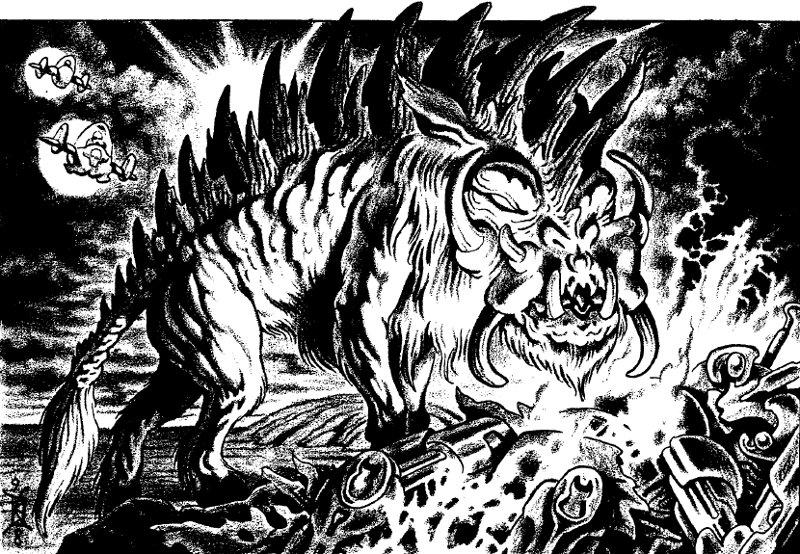
Mechabug not detailed.
A Razorback (49-538 M.D.C.) is a monster boar from another world, though apparently Indigenous people insist it's a mutant. They claim the Dreamtime warped wild pigs into monsters because they're "false" creatures from another place with no connection to the land, and they live in constant pain and fury as a result. Whatever the case, they're constantly aggressive, and love "cat and mouse" games like wrecking supplies, which checks that Siembieda trope. They're sadistic and love killing, like you do. Sometimes they're in packs! Either way, we get about two full pages talking about how mean they are. I get it.
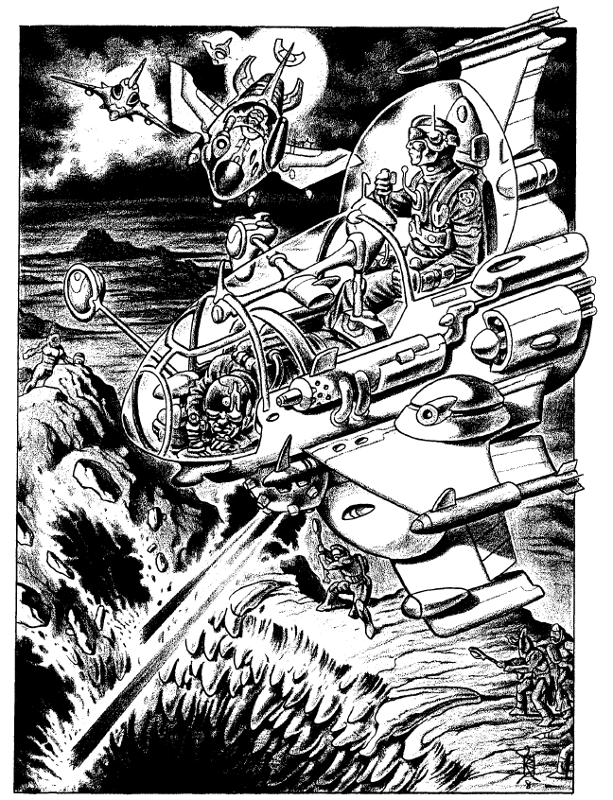
"Is hunting a sport?" "Of course it's a sport! This is sporting!"
Finally, the Sand Fiend (1800 M.D.C.) is... well, it's the sarlacc from Return of the Jedi with a little more mobility since it can drift around under the sand or slowly lunge out. They're only really dangerous if they catch you unaware, but divide asexually and are a growing danger in the desert, requiring people to try and keep them in check through air attacks or the like. It has some minor psionics, but those largely seem to be there to sense prey or to empathically manipulate people into its maw.
Next: Dingo ate my character!
"Aboriginal people cannot be made into vampires."
Original SA post
Rifts World Book 19: Australia, Part 10 - "Aboriginal people cannot be made into vampires."
Demons & Spirits
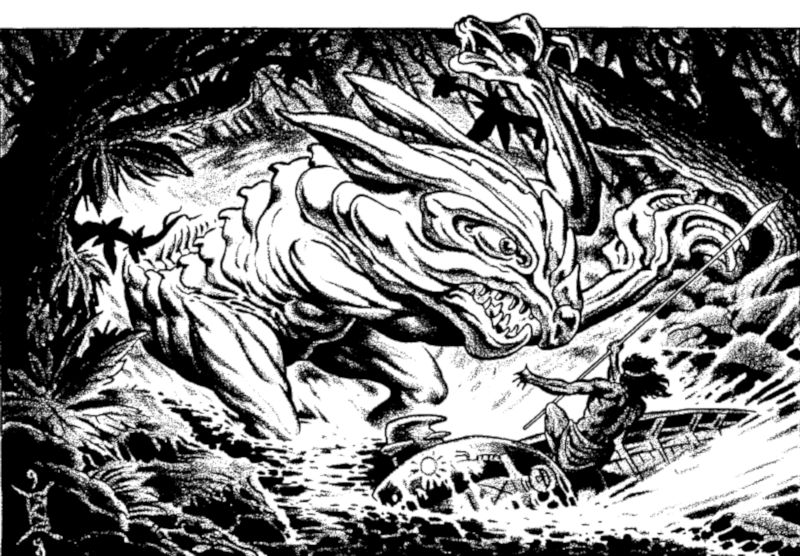
Tourists! Come take a dip with a friendly bunyip!
The Bunyip (150-270 M.D.C.) is a Dreamtime demon and boogeyman, living in watery domains and often lunging out from the water's surface to pull people under. They vary a lot in appearance (so we don't have to sweat if the artist drew it "wrong"), but are generally twenty-plus feet tall with large claws and maws. They prefer to kill and eat Aborginal Australians because
 . They often try and settle down in a community's waterhole, killing those who venture near and polluting it with corpses. Sometimes it will apparently hibernate under mud, which makes Indigenous people wary about crossing mud flats. It is claimed by some that they lived on Earth in ancient times, and simply waited out times of low magic and water before reemerging. In addition to being enormous aquatic predators, they can become two-dimensional like the Shadow People, and get some minor illusionary magic and minor psychic powers.
. They often try and settle down in a community's waterhole, killing those who venture near and polluting it with corpses. Sometimes it will apparently hibernate under mud, which makes Indigenous people wary about crossing mud flats. It is claimed by some that they lived on Earth in ancient times, and simply waited out times of low magic and water before reemerging. In addition to being enormous aquatic predators, they can become two-dimensional like the Shadow People, and get some minor illusionary magic and minor psychic powers.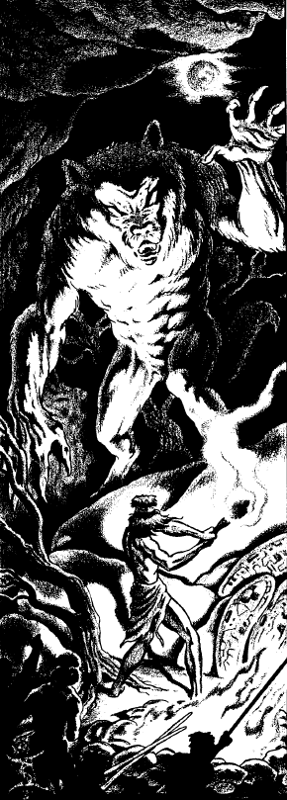
"Hey, neighbor! Got a baby I could borrow?"
Though supposedly created as a protector of animals, the Devil Dingo (153-213 M.D.C.) somehow became a warped monster that terrorizes animals and humans alike. Though described as if singular, there are vague references to there being more than one giant dingo-man that feeds on fear. Apparently as - sigh - a "sadistic and malicious" creature, he likes to try and manipulate people to turn against each other, or at least separate them to terrorize them more easily. He can be goaded into combat, particularly by those that resist his terror tactics, and at that point is most vulnerable. He can take on the form of a feral-looking man, dingo-man, giant dingo, or a mist-like form. He has a special fear attack where he can spend an attack once per round to re-inflict his Horror Factor of 15, and has a variety of illusion spells and psychic mind-affecting powers to manipulate people with.
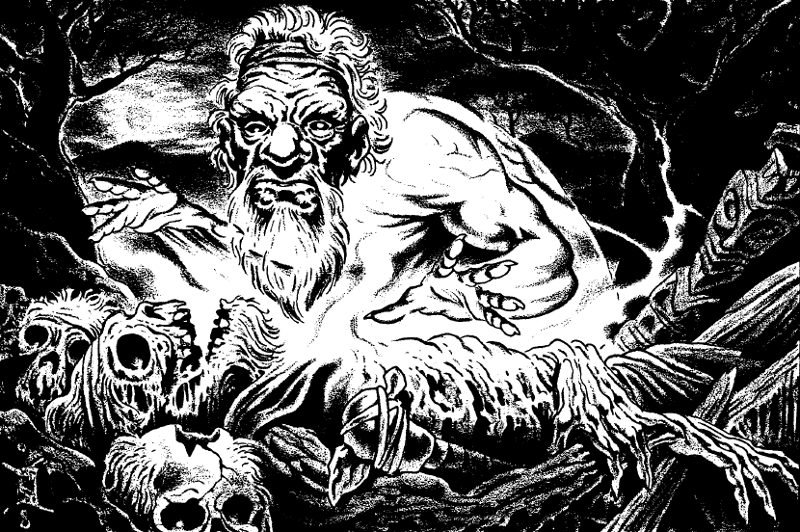
"I've returned to talk about unfair evil ghost distribution between indigenous and non-indigenous people!"
A Mopaditis (13-180 M.D.C.) is, we're told, a ghost of a Indigenous Australian that dies in the wild unburied. Supposedly they can be appeased by taking a living spirit to accompany them to the afterlife, which sounds like an interesting hook until we're told that's not true at all! Instead, they're just angry murder ghosts who are too stubborn to die. Dammit, that was almost a good dilemma to present players with. They only have dim memories of their former life, but enough to usually target those they know first and foremost. It turns out non-indigenous people can become them too, but 4 out of 5 come from aboriginal people. However, they can only attack people who attack the Mopaditis first, or those who ask to be killed. Granted, they can float around harassing, threatening, and goading people, so they do. They're immune to just about everything but magic (and magic weapons), mental psionic attacks, and various forms of turn dead or exorcism. They can also create other Mopaditis... es?... if a nongood character volunteers to have themselves turned into one. There's a 70% chance of it working, otherwise, they just die. Well, it's betting odds, at least.
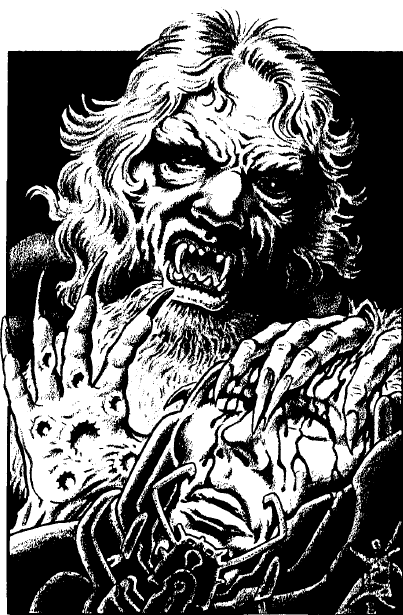
Morbius really let himself go.
Vampires exist in Australia due to an a Vampire Intelligence (as detailed in Rifts World Book One: Vampire Kingdoms) setting up shop on the continent... somewhere. However, the Dreamtime apparently represses supernatural intelligences, and so the big tentacle-blob has a harder time keeping a reign on its vampires. It also notes that Aboriginal Australians are apparently protected from becoming vampires. They're special, in case you didn't hear! Apparently wild vampires are less common (which contradicts some of this text, so I don't know what they're getting at) but half of the wild vampires created become "mutants" known as the Yara Mayha Sho (37-142 M.D.C.). These Australian vampires are far weaker, using suckers on their hands to feed, and don't have any of the transformation or psionic powers of normal vampires, but aren't really beholden to the intelligence. They can be killed by the normal stake, decapitate, and burn head and body separately method. However, they can also be killed by drowning, being chopped up, and fed to sharks. They're not vulnerable to crosses or running water, however. This is really a "vampirization" of the yara-ma-yha-who myth, who are froggy guys who suck blood through their hands, but they weren't ever human in mythology.
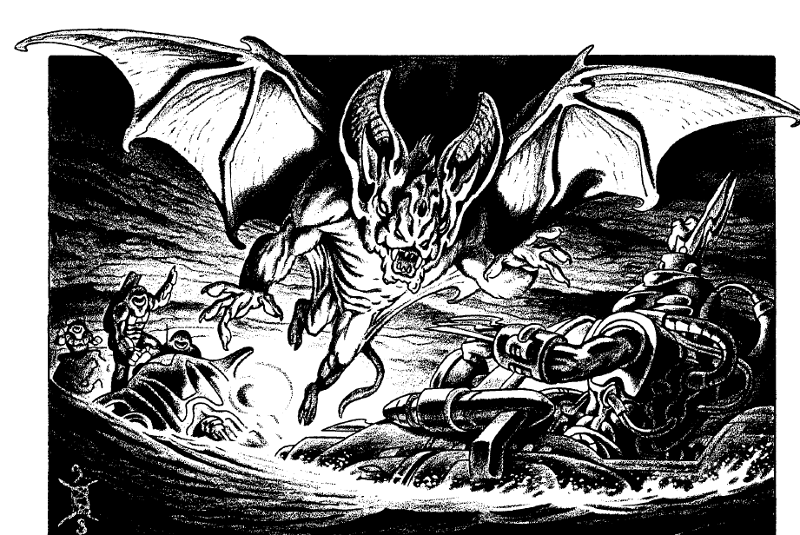
Bat country.
Though the Garkain might look like an alternate vampire at first galance, it's just a man-bat and "Dreamtime demon" that's more of a monstrous predator. It mostly just eats people, though for some reason it sees vampires as kin and is inclined to obey them. Other than being a flying mega-damage predator (with the powers you'd expect - nightvision, regeneration, etc.), it's only unusual power is to turn into a bat. Mostly just a mook for tougher vampires to throw at player characters.
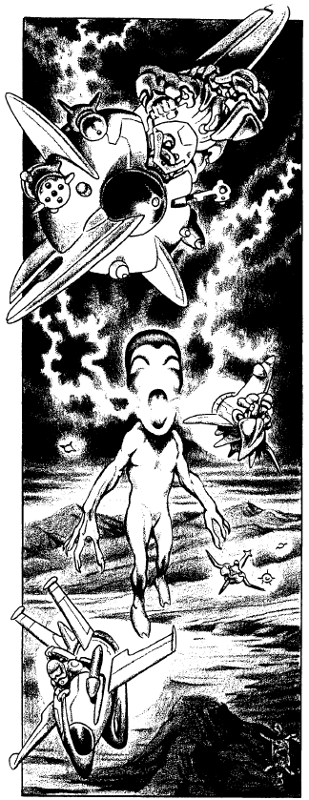
"Look out! Giant baby on your six!"
The origins of the Wandjinas (180-225 M.D.C.) are mysterious; they may be demons or some other kind of magical creature. In any case, they're big pale eyeless twenty-foot baby-things that never talk save for a hum or moan. They can manipulate the weather and even create Ley Line Storms, and usually do that to weaken humanoids and humanoid communities before moving in to consume them. They only feed upon the critically injured or recently dead, for whatever reason, and don't consume magical creatures. Sometimes they just fuck with the weather for whatever mysterious games or ends. As far as powers go, they can manipulate the weather, create "weather blasts" from lightning to hail, and when killed they explode and create a storm. They have a large variety of magic, focusing upon but hardly limited to air and weather magic. Probably one of the more suitably eerie monsters I've seen in Rifts for awhile - the art and the description actually work pretty well together.
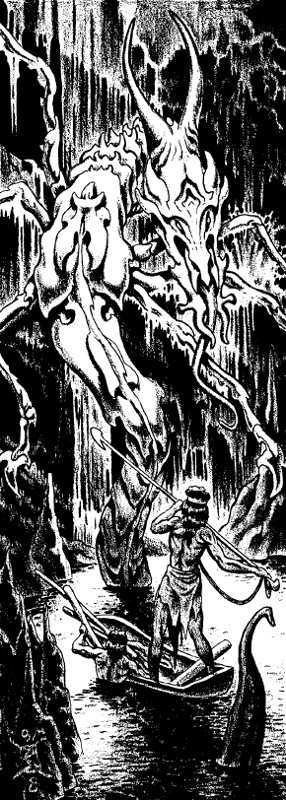
"Seriously, I have like 1000 M.D.C., you can stop poking at me."
Yowies (430-1230 M.D.C.) are demons from the myths of indigenous people, we're told. They're lizard-insect creatures, voracious predators that - of course - prefer eating people over animals. While they're intelligent and can be bargained with, they're not particularly cunning or subtle and can be angered pretty easily. They're really tough fighters at nearly 1000 M.D.C., and get a variety of seemingly random spells. Also, they can turn into centipedes. However, they're cowardly and generally bug out when even modestly injured. It just feels kind of like a generic big demon with no particular theme to make it unique other than being loosely based out of mythology. I mean, very loosely based - the Yowie of myth is more akin to a bigfoot or yeti archetype.
Next: Godtime for the Dreamtime.
"Damage: Demon Frogs can chew up and swallow a single giant leaf in one melee round (15 seconds) and each bite does 1D4x10 M.D. to the Tree, enabling them to bite off small branches, gnaw through large branches in a matter of a minute or two (6-10 bites), strip its bark and take hunks out of its trunk!"
Original SA post
Rifts World Book 19: Australia, Part 12 - "Damage: Demon Frogs can chew up and swallow a single giant leaf in one melee round (15 seconds) and each bite does 1D4x10 M.D. to the Tree, enabling them to bite off small branches, gnaw through large branches in a matter of a minute or two (6-10 bites), strip its bark and take hunks out of its trunk!"
Gods of the Dreamtime
To Ben Lucas' credit, we get writeups for Aboriginal gods that are more practical than usual. Or, at least, I'm presuming this is his doing, given that this is the first time a deific section in Rifts has balked at statting out gods.
Bunyil (no relation to the Bunyip) is a creator god that created humanity, though the stories of which vary. Though venerated, he's never worshiped directly. There are no stats for him presented, as apparently he's more of a "force" than an anthropomorphized being. I couldn't find any source in myth for this one; sometimes the Rainbow Serpent has been called "Bunyip" amongst its dozens of names, but that's presented separately...
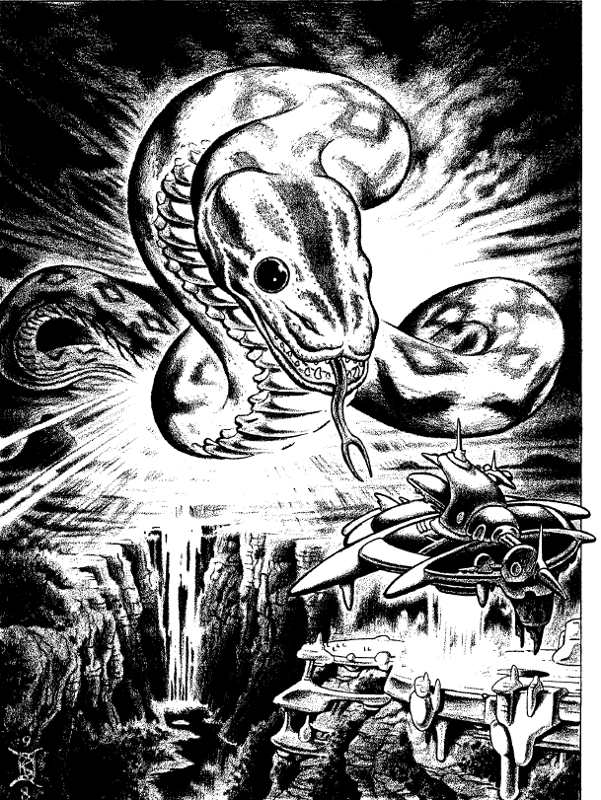
megasnek
... speaking of which, the Rainbow Serpent also doesn't get direct stats, apparently having left this dimension long ago after creating the rivers and filling them with water. However, sometimes he sends a smaller avatar fragment to Earth in order to clean house and defeat great evil, but only briefly and only when absolutely necessary. Apparently this effort is costly and that's why he doesn't do it too often - only three times after the coming of the rifts. Once he did it to prevent Australia's destruction (somehow), once to close a rift that threatened the entire continent, and once to battle Tikilik. Generally, he only shows up to fight great supernatural evil and isn't concerned with affairs between humans. (Which is a better explanation than "well humans have to find their own way...")
His avatars have 12,000 M.D.C., regenerates insanely fast, is immune to many forms of damage aside from magic, psionics, or rune weapons, is impervious to lightning and lasers, shoots massive eyebeams (1d6 x 100 M.D.), controls the weather, and can "swallow evil" either to destroy an evil or banish it to a distant dimension that will apparently take an average of 10-11,000 years to escape. Swallowing requires the avatar to peace out, however, to carry the evil creature or being away. Oh and he has all air and water magic and psionics etc. Based on this, the Rainbow Serpent is basically on a whole other level compared to other Rifts gods, with an "avatar" that's more powerful than many deities previously statted.
There's also a throwaway reference to a "Black Strip" that threatens the seemingly-sentient Great Reef, but no further details are provided.
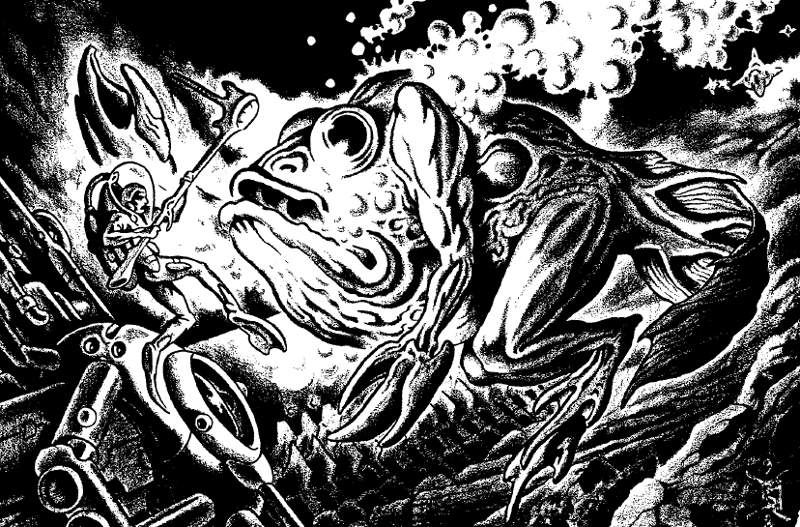
"Seriously, I'm a prince!"
Similarly, Tikilik doesn't get direct numbers. He's supposed to be the giant frog devil of the Dreamtime, and drains water and causes droughts. Now somehow linked to Australia, an avatar of his is being born in the inland sea that within a century or two will reduce Australia to a dry husk. It's apparently sending out frog demons to drain ley lines and cause droughts. Though many are slain, the number sent out each year doubles. The demon frogs (or frog demons, the paragraphs can't decide) are one of the few creatures that can consume Millennium Trees (from Rifts World Book Three: England, but being present in Australia as well), being immune to the energy blasts and magic explosions the trees might use to defend themselves. It's said that Tikilik is one of the "Seven Dangers" prophesied wayyy back in Rifts Sourcebook Two: The Mechanoids, which seems believable. Of course, those aware of the prophecy in America (and Europe and Africa) have no real awareness of Tikilik due to Australia's isolation.
The frog demons are twenty foot-long monster frogs with claws, and are pretty tough (average of 220 M.D.C.). While they can talk, they aren't terribly bright and are more bestial and instinctual than deliberate. In any case, they can sense ley lines and use them to teleport closer to a Millennium Tree, or drain everything magical of P.P.E. along a ley line for about a half-mile. Similarly, they can't be harmed by Millennium Tree items and can consume the trees without harm. Though not a massive threat physically, the frogs are clearly a potent threat to the magical well-being of Australia, and their special abilities are a pretty good spur for player characters to go out and defeat them.
This may be the only god section I've seen so far that's... alright? Or, at the very least, is relatively functional and has some definite hooks that can be used to drive a big quest to save Australia.
Rifts World Book 19: Australia posted:
Other Spirits & Animal Totems
Animals, Animal Totems and other Dreamtime beings will be presented in Rifts® Australia Two: Mystic Australia™. There will also be data about Australian Millennium Beings, Crystal Magic, Aboriginal characters, Aboriginal magic and more. Coming Summer 1999.
Nope!
Next: Whose is that jumbuck you've got in your tucker bag?
"The name is an Outback joke inspired by legends of the old Glitter Boys and the clean, shiny power armored troops of the Tech-Cities — the joke being that power armor in the Outback have lost their sparkle and shine."
Original SA post
Rifts World Book 19: Australia, Part 14 - "The name is an Outback joke inspired by legends of the old Glitter Boys and the clean, shiny power armored troops of the Tech-Cities — the joke being that power armor in the Outback have lost their sparkle and shine."
Power Armor
As one can guess after the rest of the equipment section, power armor is pretty rare in the Outback and pretty well prized, sometimes being passed down through families. They tend to be either stolen from the tech-cities or cobbled tother from foreign or pre-rifts suits. Often they look properly post-apocalypse ramshackle with spikes or monster teeth attached. Few have nuclear power sources of any sort. The cities actually offer to buy any power armor suit for a solid price, in the hopes of keeping that technology outside of outsiders. Very rarely they will provide them to valued Outback agents at a high price. While there are Glitter Boy suits (from American military bases in the Pacific) and suits of armor originating from Asia and Japan floating around, they're extremely rare.
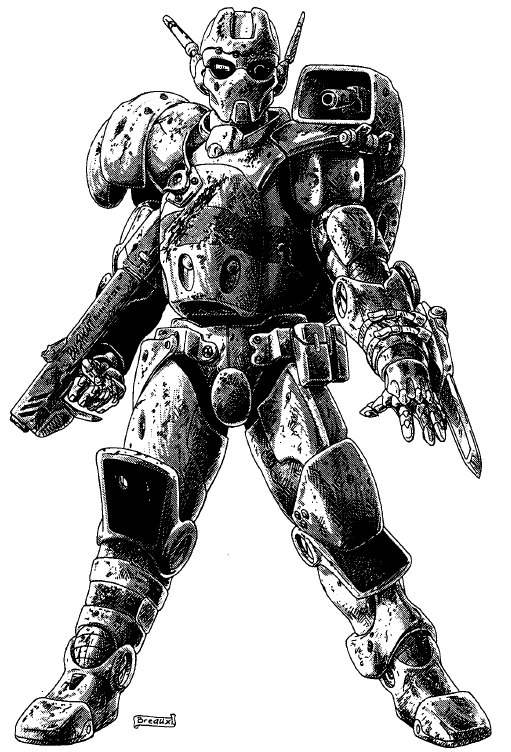
"Rusty" was taken a little literally, I suppose.
We get two main suits of power armor listed. The first is the "Rusty", aka the tech-city APAA/Assault Power Armor Alpha, so named because it's just a pale shadow of the legends of Glitter Boys and their ilk. While the tech cities produce them, some have emerged from the Outback or Pacific Rim region as knock-offs. There's a rumor there's some secret Outback manufacturer, or that the tech-cities sell them with bugs so they can be tracked and watched. In any case, they're pretty low-grade, being on the bottom end (200 M.D.C.) compared to power armor from any other supplement, but it's possible to upgrade their armor as much by 50%. The generally have vibro-blades in the arms, but generally vary otherwise - they might have arm weapons (taken from the bionics weapon list) or things like jet packs and other gadgets. We're given a wide variety of shoulder weapons that are typically mounted on them, most of which are pretty middling. Lastly, though I rarely talk about the combat bonuses armor gets, the Rusty's are notable in that its bonuses are so low they're not worth describing.
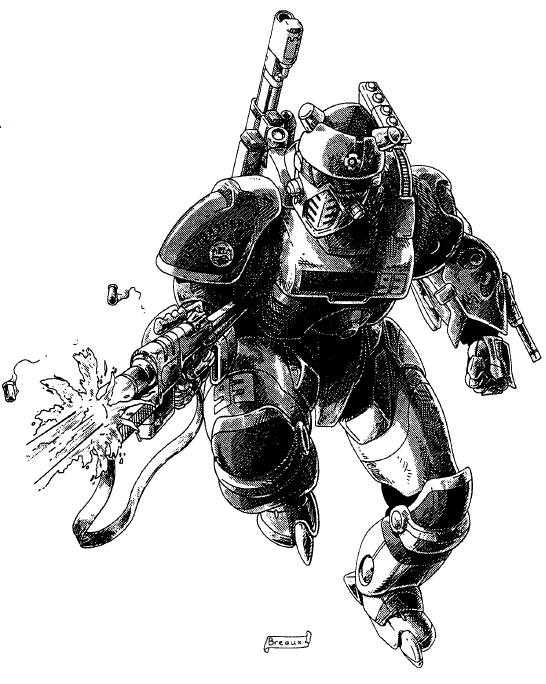
Unleash the bellybutton of war!
The second suit is the "Bushbasher", aka the X50 Assault Power Armor Beta. It's slightly better armored, and comes with "concealed" forearm lasers, vibro-blades, a belly flamethrower ("fear my navel flames!"), a small mini-missile launcher, and a shoulder weapon like the Rusty. It's generally just an upgraded version of the Rusty, though I have questions about having a flamethrower fuel tank right on your chest or stomach.
Rifts World Book 19: Australia posted:
There are a few heavier, larger types of power armor, including the Platypus and Security Commando, as well as other vehicles, but space limitations prevent us from presenting them here. See Rifts® Australia Two: Mystic Australia for their descriptions and more world information, along with magic and Aboriginals.
Nope.
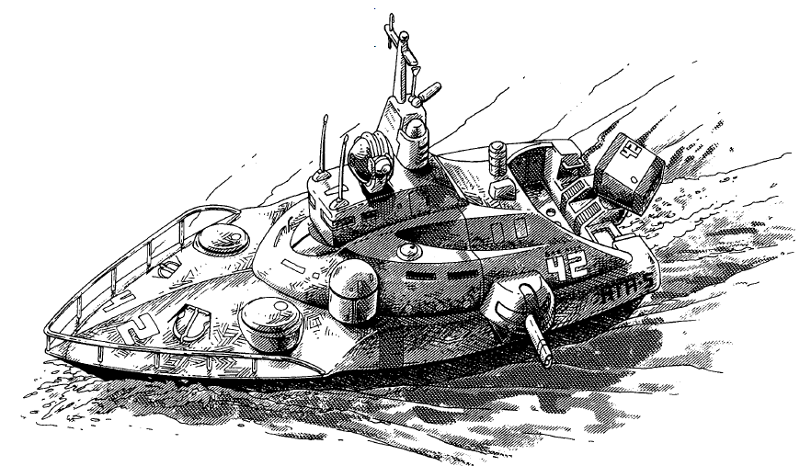
Why I don't usually copy the boat art: 80% is like "modern boat + turrets= future boat".
Notable Vehicles
We're told that there are a lot more vehicles available, and suggests we adapt stuff from other books. However, we do have some vehicles manufactured by Perth and Melbourne.
- "Devil" 4x4: Personal transportation is rare inside the cities, and only the military or rare elite have vehicles like this. Despite the self-destruct mechanism built into military models, a fair number of these have fell into the hands of Outbackers who have learned to disable it. It's honestly pretty weak (225 M.D.C.); the military model has a grenade launcher and rail gun, though it can have up to two more weapons mounted.
- "Crawler" APC: A decently tough (440 M.D.C.) half-track used to transport troops with a mini-missile launcher and a turreted gun (rail gun, laser cannon, or particle beam; you want the particle beam). Nothing too special, otherwise.
- "Slicer" Patrol Boat: The most heavily armed and armored of the vehicles here (500 M.D.C.), this has rail guns or lasers (you want the rail gun), mini-torpedoes, and mini-missiles. It's used for patrols and light transport, like you do. Also this has been true of other vehicles, but it's quaint to see each one has a CD player for "one-inch" CDs. Quaint!
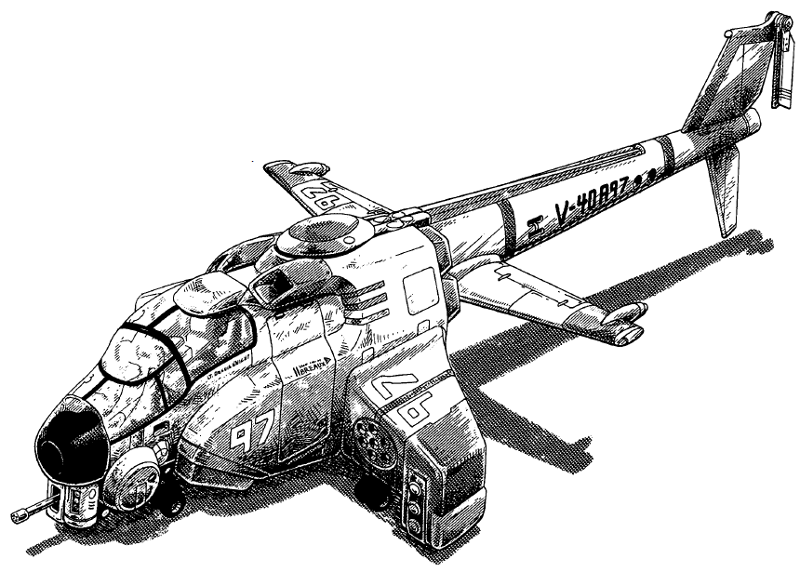
Looks nothing like the city helicopters from earlier, of course.
- "Viper" Attack Chopper: The iconic response vehicle for the tech-cities, theses often patrol the region around the tech-cities. While not terribly durable (210 M.D.C.), their rail guns and mini-missiles seem pretty average... but the medium-range missiles they carry are one of the biggest damage dumps we've seen in Australia. They also apparently often equipped with tripod weapons for door gunners to use. They have "limited stealth capability" that has no rules effect, and reserve rotors. That is, it can eject a failing set of rotors and unfold the backup ones if necessary, though it might still crash if it's too low to the ground.
- VR-500X "Stinger" Robot: These are small, man-sized drone choppers (60 M.D.C.) that are seen as disposable, with rail guns and mini-missiles, and often sent out alongside Vipers or on patrols. They're usually piloted through a VR system - they can also operate as autonomous robot drones, but "all bonuses are reduced by half". Wait, what bonuses? Like, does the robot brain have a set of bonuses that are always halved? Well, nothing is listed. It's confusing.
- One & Two Man Flyers: A vehicle obviously just copy-pasted from the Sand Fiend and other Kent Burles art, and is deeply, deeply
 ; I get a feeling Siembieda slapped it in at the last moment to fill page count. It isn't even given consistent M.D.C. (200-300), and has a "nose gun" and "secondary guns" of an undetailed nature, as well as mini-missiles and medium-range missiles (I sometimes think Siembieda forgets short-range missiles exist). Why, if the tech-cities have this anti-grav hover tech, do they fuck around mostly with helicopters?
; I get a feeling Siembieda slapped it in at the last moment to fill page count. It isn't even given consistent M.D.C. (200-300), and has a "nose gun" and "secondary guns" of an undetailed nature, as well as mini-missiles and medium-range missiles (I sometimes think Siembieda forgets short-range missiles exist). Why, if the tech-cities have this anti-grav hover tech, do they fuck around mostly with helicopters? 
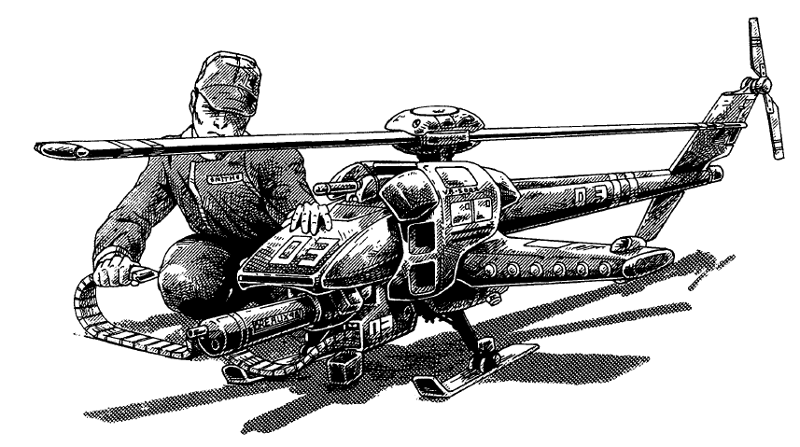
Unleash the RC of war!
Conclusions
Australia is kinda neat in the way it tries to rebalance Rifts a little with a lower-tech, more "post-apocalypse" setting (as opposed to post-post-apocalypse), and actually has some interesting hooks for most of its supernatural shenanigans. However, it falls back on the typical Rifts notion of magical indigenous people in the usual tiresome fashion, and it's probably a small mercy we didn't get Mystic Australia. However, there is enough unique stuff like mutants, songjuicers, and kwarla to at least keep it interesting. While it's not the best ever, it's at least an interesting book that's genuinely trying to do something different, and though I give the sideeye at the notion of further Australia books making noble magic special people out of Aboriginal Australians, I would have liked to have seen Ben Lucas try some more writing on the line.
However, rumor has it that Palladium actually got two manuscripts from Ben Lucas for the next two Australia books that were then shelved by Palladium, to his chagrin. Another rumor says that Mystic Australia and Dreamtime were shelved by Siembieda, who felt it went too far and would likely offend people. (Which sort of people is less clear.) There's also talk that Siembieda made some last-minute changes, like changing the Molokoi from an S.D.C. race with acid guns to the terrifying (for the Australia setting) techno-wizards they became. But all that's - and I'll emphasize this - only rumors. It also could have been fan backlash on the lower power level and frog-based villainy that caused Siembieda to want to turn things back towards the Americas, or just generally low sales on the book. Either way, it's likely the last we'll see of Rifts Australia in the foreseeable future.
Toodle-oo.